#How to Set Up Tag manager For Seamless Google Analytics Integration
Text
How to Set Up Tag manager For Seamless Google Analytics Integration

In the digital age, data is the backbone of informed decision-making for businesses and marketers. Google Analytics is a powerful tool that provides valuable insights into website performance, user behavior, and marketing effectiveness. That’s why we’re here to introduce you to the game-changer: Tag Manager. By setting up Tag Manager for seamless Google Analytics integration, you can simplify your data tracking process like never before. Say goodbye to complicated codes and hello to a smooth and effortless way of monitoring your website performance. So, let’s dive in and discover how this powerful tool can revolutionize the way you handle your analytics – all while saving time and boosting productivity!
What Is Tag Manager?
Tag Manager is a tool that allows you to easily add and manage your website’s tags, including those for analytics and marketing platforms like Google Analytics. By using Tag Manager, you can avoid having to hard-code tags into your website’s code, making it simpler to keep your tags up-to-date and accurate. In addition, Tag Manager can help you better manage your website’s data collection by giving you control over when and how tags are fired.
Benefits Of Using Tag Manager For Google Analytics Integration
If you manage a website, there’s a good chance you’re using Google Analytics to track your site’s traffic and performance. Google Analytics is a powerful tool that provides a wealth of data about your website visitors. However, setting up tracking for all of the different web pages on your site can be a challenge.
This is where Google Tag Manager comes in. Tag Manager is a free tool from Google that makes it easy to add and manage tracking code on your website. With Tag Manager, you can quickly and easily add Google Analytics tracking code to all of your web pages without having to edit each page individually.
Tag Manager also makes it easy to track events on your website, such as clicks on links or buttons. This data can be extremely valuable in understanding how visitors interact with your site and what they’re interested in.
Using Tag Manager can simplify your data tracking process and make it easier to get the most out of Google Analytics. If you’re not using Tag Manager already, we recommend giving it a try!
How To Set Up Tag Manager
Log in to your Google Analytics account and select the Admin tab.
Under the Property column, click +Create Container.
Enter a name for your container and select Web as the platform. Then click Create Container.
Copy the code provided under Step 2: Install Tags. This code needs to be added to every page of your website that you want to track with Google Analytics.
Use a tag management system like Google Tag Manager to insert the tracking code onto your website pages. This will allow you to manage all your website tags in one place, and make it easier to add or remove tags as needed without having to edit your website code.
To set up Tag Manager, create a new account and container following the instructions on their site. Once you’ve created your account, you’ll be given a snippet of code to copy and paste onto every page of your site that you want to track with Tag Manager.
Now that everything is set up, you can start using Google Analytics tracking codes (called “tags”) within Tag Manager to track specific events on your website pages such as button clicks, form submissions, and more!
Setting Up Tags In Tag Manager
If you’re looking to simplify your data tracking, Google Tag Manager is a great solution. Setting up tags in Tag Manager is a breeze, and it only takes a few minutes to get started.
To set up tags in Tag Manager, first create a new account and container. Then, add the tags you want to track, including your Google Analytics tag. Publish your container so that the tags are live on your site.
That’s all there is to it! With Tag Manager, you can easily manage all of your tags in one place, making it simple to keep track of your data.
Configuring Triggers And Variables In Tag Manager
When you’re ready to take your Google Analytics implementation to the next level, Tag Manager is the tool for you. Tag Manager simplifies the process of tracking page views, events, and other interactions by allowing you to set up triggers and variables that will do the heavy lifting for you.
To get started, sign in to your Google Analytics account and navigate to the Admin page. In the Property column, click on Tag Manager. If you don’t see Tag Manager listed, it may not be available for your account yet – in this case, you’ll need to contact your Google Analytics administrator.
Once you’re in Tag Manager, click on Create Container. You’ll be prompted to give your container a name and choose where it will be used – choose Web if you’re planning on tracking interactions on a website. After you’ve created your container, you’ll be given a code snippet that needs to be added to every page of your site. The easiest way to do this is to add it as a custom HTML tag in your site’s template.
Now that your container is set up, it’s time to configure some tags. Tags are snippets of code that correspond to the actions you want to track (such as pageviews or clicks). To create a new tag, click on the New Tag button and choose the type of tag you want to create from the list of options.
Most tags will require some sort of trigger – this is what tells Tag Manager when to fire the tag. To create a trigger, click on the New Trigger button and then select the type of trigger you want to use. You can choose from pageview, click, form submission, and more.
Finally, you’ll need to set up some variables. Variables are pieces of information that you can use in your tags and triggers (such as the URL of the page being viewed). To create a variable, click on the New Variable button and then select the type of variable you want to use. You can choose from fields like Page URL, Page Hostname, and Referrer URL.
With tags, triggers, and variables configured, you’re ready to start tracking interactions on your website! Tag Manager makes it easy to keep track of user behavior – all without having to write any code.
Testing Your Tagging Setup
Assuming you’ve already decided to use Google Tag Manager (GTM) to deploy your Google Analytics tags, the next step is testing your setup before going live. This is important because it allows you to verify that your tags are firing correctly and passing the right information to Google Analytics.
The first thing you need to do is create a new container in GTM. This will be your test container, which you will use to test your tags before publishing them to your live site. Once you’ve created the test container, you can add any tags that you want to test.
Next, you need to create a test page on your website. This can be a simple page with just a few elements, or it can be an existing page that you know receives traffic. Once the test page is created, add the GTM code snippet to it.
Now it’s time to actually test your tags. To do this, you’ll need to use the Preview mode in GTM. When Preview mode is enabled, GTM will load all of your tags on the pages that you visit, but those tags will only fire when the preview mode is active. This allows you to see exactly what would happen when those tags are fired on a real pageview.
To activate Preview mode, click the “Preview” button in the top-right corner of the GTM interface. Then navigate to your test page and interact with it as you normally would. As you do so, the tags that you’ve set up will fire and appear in the “Tags Fired On This Page” section of the GTM interface.
Once you’re satisfied with your tagging setup, you can go ahead and publish your changes to your live site. To do this, click the “Submit” button in GTM and give your container a descriptive name (e.g., “Analytics tags – July 2019”). This will make it easier for you to keep track of which versions of your tagging setup are currently live on the site.
Optimizing Your Tagging Setup
Assuming you’ve already decided to use Google Tag Manager (GTM) for your web tracking needs, the next step is setting up your tags. The process of optimizing your tagging setup can be broken down into a few key steps:
Choose the right tags for your needs. There are a variety of different types of tags available, each with its own strengths and weaknesses. Be sure to select tags that will best meet the needs of your website or app.
Configure your tags properly. This step is crucial in ensuring that your tags are firing correctly and accurately capturing the data you need.
Test, test, test! Once you have your tags set up, it’s important to verify that they are working as intended. The only way to do this is through careful testing.
By following these steps, you can be confident that your GTM setup is optimized for success.
Alternatives To Using Tag Manager With Google Analytics
If you’re not using Google Tag Manager to manage your Google Analytics tracking code, you’re missing out on a valuable tool that can save you time and simplify your data tracking. Here are some alternatives to using Tag Manager with Google Analytics:
Use the Google Analytics Tracking Code Helper Plugin for WordPress
The GA Tracking Code Helper is a free WordPress plugin that allows you to easily add the Google Analytics tracking code to your website. Once installed, simply enter your GA Tracking ID and the plugin will automatically insert the tracking code into the header of your website.
Add the GA Tracking Code Manually
If you’re not using WordPress, or if you prefer not to use a plugin, you can add the GA tracking code manually to your website’s header file. Simply copy and paste the following code into your header file, replacing YOUR_TRACKING_ID with your actual GA Tracking ID:
#How to Set Up Tag manager For Seamless Google Analytics Integration#web development#web design#best web development company in united states#website landing page design#logo design company#web development company#web designing company#asp.net web and application development#digital marketing company in usa#magento development
0 notes
Text
Streamline SEO: Top Management Software for Companies
Are you ready to take your company's online presence to the next level? In today's digital age, search engine optimization (SEO) is crucial for businesses looking to thrive in the competitive online landscape. But with so many moving parts and strategies involved, managing SEO can quickly become overwhelming. That's where management software comes in! In this blog post, we'll explore the top SEO management software options available for companies like yours. We'll discuss how streamlining your SEO efforts can lead to increased visibility, higher rankings, and ultimately, more conversions. So buckle up and get ready to learn how you can streamline your SEO game with these powerful tools. Let's dive in!

What is SEO?
In today's digital landscape, SEO plays a pivotal role in determining the success of your online presence. But what exactly is SEO? Well, simply put, it stands for search engine optimization. It encompasses a set of strategies and techniques aimed at improving your website's visibility on search engines like Google.
When someone searches for a particular keyword or phrase related to your business, you want your website to appear among the top results. That's where SEO comes into play. By optimizing various elements on your website such as keywords, meta tags, content quality and backlinks, you can increase your chances of ranking higher in search engine results pages (SERPs).
But SEO isn't just about appeasing search engines - it's also about creating a seamless user experience. When implemented correctly, SEO can enhance the usability and navigation of your website while delivering relevant and valuable content to users.
In essence, SEO is all about striking the perfect balance between optimizing for search engines and providing an exceptional user experience. By understanding how it works and implementing effective strategies, you can boost organic traffic to your site and drive meaningful conversions.
Ready to take control of your company's online visibility? Let's explore some top management software options that can streamline this process for you!
What is the best management software for companies?
When it comes to managing your company's SEO efforts, having the right management software is essential. With so many options available, it can be overwhelming to choose the best one for your business. However, there is one software that stands out from the rest: Clientvenue.
Clientvenue offers a comprehensive suite of tools and features specifically designed for companies looking to streamline their SEO processes. From keyword research and analysis to competitor tracking and reporting, this platform has you covered.
One of the standout features of Clientvenue is its intuitive interface that allows users to easily navigate through different sections and perform tasks with ease. Whether you are new to SEO or have years of experience under your belt, this software makes managing your campaigns a breeze.
Not only does Clientvenue provide robust analytics and reporting capabilities, but it also offers integration with other popular tools such as Google Analytics and Google Search Console. This means that you can access all of your data in one place, saving you time and effort.
In addition, Clientvenue provides excellent customer support with knowledgeable experts who are ready to assist you whenever you need help or have any questions. They understand that every business is unique and will work closely with you to ensure that their software meets all of your specific needs.
To sum it up, if you're looking for the best management software for companies seeking streamlined SEO processes, look no further than Clientvenue. With its user-friendly interface, powerful features, seamless integrations, and exceptional customer support team - this platform has everything you need to take your SEO efforts to new heights.
How can I streamline my SEO?
When it comes to streamlining your SEO efforts, there are several key steps you can take to ensure maximum efficiency and effectiveness. Conducting thorough keyword research is essential. By identifying the most relevant and high-performing keywords for your industry or niche, you can optimize your website content accordingly.
Next, creating a well-structured and user-friendly website is crucial for streamlining SEO. This includes organizing your site's navigation in a logical manner, optimizing page load speeds, and ensuring mobile responsiveness.
Additionally, regularly monitoring and analyzing your website's performance through tools like Google Analytics will provide valuable insights into areas that may need improvement. By tracking metrics such as organic traffic, bounce rate, and conversion rates, you can make data-driven decisions to enhance your SEO strategy.
Another important aspect of streamlining SEO is link building. Building high-quality backlinks from reputable websites not only improves search engine rankings but also drives targeted traffic to your site.
Staying up-to-date with algorithm updates and industry trends is vital for maintaining a competitive edge in the ever-evolving world of SEO. Regularly reading industry blogs or attending webinars will keep you informed about new strategies and best practices.
By implementing these strategies consistently over time, you can streamline your SEO efforts and achieve long-term success in improving organic visibility for your website.
What are some benefits of streamlining SEO?
Streamlining your SEO efforts can have numerous benefits for your company. Here are some of the key advantages you can expect when you streamline your SEO:
Increased Efficiency: By using management software specifically designed for SEO, you can automate various tasks and processes, saving valuable time and resources. This allows your team to focus on more strategic initiatives and drive better results.
Better Collaboration: Streamlined SEO software often includes collaborative features that enable different team members to work together seamlessly. This promotes effective communication, eliminates bottlenecks, and ensures everyone is on the same page.
Improved Reporting: With streamlined SEO tools, you gain access to comprehensive reporting capabilities that provide valuable insights into your website's performance. These reports help you track key metrics, identify areas for improvement, and make data-driven decisions.
Enhanced Keyword Research: Effective keyword research is crucial for a successful SEO strategy. Streamlined software simplifies this process by providing keyword suggestions, search volume data, competition analysis, and other essential information – all in one place.
Optimized Content Creation: When streamlining your SEO efforts with management software, you can optimize content creation by integrating keyword recommendations directly into the writing process. This ensures that every piece of content aligns with targeted keywords and enhances organic visibility.
Competitor Analysis: Many streamlined SEO tools offer competitor analysis features that allow you to monitor their strategies and stay one step ahead. Understanding what works well for competitors helps inform your own optimization tactics.
By streamlining your SEO with specialized management software like Clientvenue ,you can unlock these benefits while maximizing efficiency across all aspects of your optimization efforts.
How can I get started with streamlining my SEO?
Getting started with streamlining your SEO doesn't have to be overwhelming. In fact, there are a few simple steps you can take to get on the right track and start seeing results.
It's important to conduct a comprehensive audit of your website. This will help you identify any areas that need improvement and give you a clear picture of where you currently stand in terms of SEO. Look for things like broken links, slow page load times, or duplicate content.
Next, keyword research is key. By understanding what keywords your target audience is searching for, you can optimize your content accordingly. Use tools like Google Keyword Planner or SEMrush to find relevant keywords with high search volumes and low competition.
Once you have identified your target keywords, it's time to optimize your website's on-page elements. This includes optimizing meta tags (title tags and meta descriptions), using relevant headers (H1, H2, etc.), and incorporating keywords naturally throughout your content.
In addition to on-page optimization, off-page factors such as backlinks are crucial for improving search engine rankings. Focus on building quality backlinks from reputable websites within your industry through tactics like guest blogging or influencer outreach.
Don't forget about the importance of tracking and analyzing data. Utilize analytics tools like Google Analytics or Moz to monitor traffic sources, user behavior metrics, and keyword rankings. This data will provide valuable insights into what strategies are working well and where adjustments may be needed.
By following these steps and staying committed to ongoing optimization efforts, you'll be well on your way to streamlining your SEO strategy effectively!
Conclusion
In today's digital landscape, SEO has become a crucial aspect of any company's marketing strategy. With the right management software in place, you can streamline your SEO efforts and maximize your online visibility.
By investing in top-notch SEO management software like Clientvenue, you can effectively track and analyze your website performance, keyword rankings, backlinks, and more. This powerful tool allows you to stay ahead of the competition by providing valuable insights into your SEO campaigns.
Streamlining your SEO with management software offers numerous benefits for companies. It saves time and effort by automating tasks such as keyword research, content optimization, and link building. It also ensures that all team members are on the same page with clear communication channels and task assignments.
With streamlined SEO processes in place, companies can improve their organic search rankings, drive targeted traffic to their websites, increase brand visibility, and ultimately boost conversions and revenue.
If you're ready to take control of your SEO efforts and achieve remarkable results for your business or clients' businesses alike , it's time to explore the power of management software like Clientvenue . Don't miss out! Visit Clientvenue now to learn more about how this innovative tool can transform how you approach search engine optimization.
Remember: optimizing your website for search engines is an ongoing process that requires constant monitoring and adjustment. By implementing an effective management system like Clientvenue ,you will have all the tools at hand needed to navigate through this ever-changing digital landscape successfully .
So what are you waiting for? Streamline your SEO today with the best management software available!
4 notes
·
View notes
Text
Unleashing the Power of Precision: The Role of a Google Tag Manager Expert
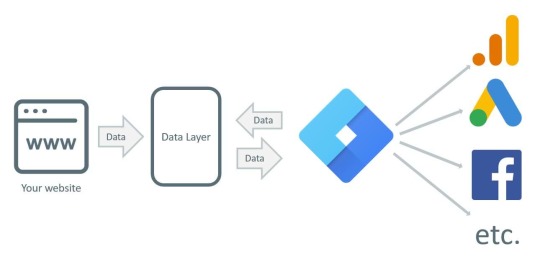
In the complex landscape of digital marketing and analytics, managing and implementing various tags, scripts, and tracking codes can be a formidable task. Enter Google Tag Manager (GTM), a powerful tool designed to streamline the process of deploying and managing tags on your website. However, to truly harness the capabilities of GTM and optimize your tracking efforts, the expertise of a Google Tag Manager expert becomes indispensable. In this blog, we'll explore the pivotal role of a Google Tag Manager expert and why their specialized skills are crucial for maximizing the potential of your online presence.
1. Efficient Tag Implementation:
Google Tag Manager allows for the seamless integration of various tags, including Google Analytics, Facebook Pixel, and custom scripts. A Google Tag Manager expert possesses a deep understanding of how to efficiently implement these tags, ensuring accurate data tracking without the need for constant manual code updates. Their expertise helps in avoiding errors and ensuring a smooth deployment process.
2. Customization for Unique Requirements:
Every business has unique tracking requirements, and a Google Tag Manager expert excels in tailoring solutions to meet specific needs. Whether it's tracking form submissions, monitoring e-commerce transactions, or capturing user interactions, they leverage GTM's flexibility to customize tags and triggers, providing you with precisely the data you need to make informed decisions.
3. Data Layer Optimization:
The data layer is a key component of Google Tag Manager, facilitating the transfer of information between your website and GTM. An expert understands how to optimize the data layer for your specific needs, ensuring that relevant data is available for tags to utilize. This optimization enhances the accuracy and depth of the data collected, contributing to more meaningful insights.
4. Event Tracking Mastery:
Google Tag Manager allows for the tracking of various user interactions, such as clicks, form submissions, and video views. A GTM expert excels in setting up and customizing event tracking, providing valuable insights into user behavior. This data is instrumental in refining your website's user experience and optimizing conversion paths.
5. Debugging and Troubleshooting:
When dealing with a multitude of tags and triggers, occasional issues and discrepancies are inevitable. A Google Tag Manager expert is adept at debugging and troubleshooting, swiftly identifying and resolving any tracking issues. Their proficiency in diagnosing problems ensures that your data is accurate and reliable, laying the foundation for informed decision-making.
6. Version Control and Rollbacks:
As your website evolves, so do your tracking needs. A Google Tag Manager expert utilizes version control within GTM to manage changes systematically. This feature allows for the creation of versions of your container, making it easy to roll back to a previous state if needed. This ensures that changes can be implemented without the fear of disrupting existing tracking setups.
7. Staying Abreast of Updates and Best Practices:
The digital landscape is ever-evolving, and Google Tag Manager is no exception. A GTM expert stays informed about updates, new features, and best practices. Their commitment to continuous learning ensures that your tracking setup remains current and aligned with industry standards.
Conclusion:
In the intricate world of digital analytics, a Google Tag Manager expert is your guiding hand, ensuring that your tracking setup is not just functional but optimized for precision. Their mastery of GTM's features, coupled with a comprehensive understanding of digital analytics principles, positions them as invaluable partners in the success of your online ventures. As you navigate the data-driven landscape, consider the pivotal role that a Google Tag Manager expert can play in unleashing the full potential of your digital analytics strategy.
0 notes
Text
EBFusion Review - Full OTO Details + Bonuses
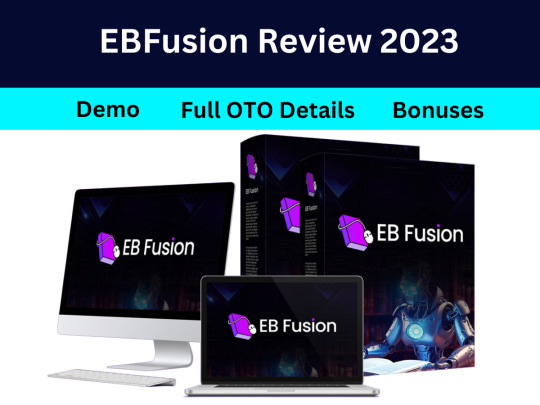
EBFusion Review – Product Overview
Product: EBFusion
Developed by: Rick NG
Visit the official website: Click Here
Initial Cost: $17
Incentives: Included
Suggestion: Strongly Recommended!
Category: Software
Reimbursement: Guaranteed Refund within 30 Days


Rick Nguyen is a highly accomplished entrepreneur recognized for his extensive range of digital products. Drawing from years of expertise in the online marketing domain, Rick has brought forth a multitude of well-received offerings such as EBStore, AIBookSite, PLR Power, and others, all presented at notably affordable prices.
Leveraging his seasoned marketing background, Rick demonstrates a keen understanding of industry trends, culminating in the conception of his latest groundbreaking creation. In this assessment of EBFusion, I will uncover the unique features and benefits that this platform/system provides, enabling modern marketers to maximize their business potential.
EBFusion Review – What is EBFusion?
Instantly Convert Boring PDFs, Texts, & Images Into Stunning Ebooks Your Ebook is automatically created with top-class designs. Everything is beautifully designed and your Ebooks are fully mobile responsive…Your customers will be able to read your Ebooks on mobile & tablet as well. Create your own ebooks in seconds & sell them for 100% profits.
EBFusion is a powerful software for creating ebook stores, designed to cater to users of all proficiency levels, from beginners to seasoned individuals. It serves as an excellent choice for aspiring entrepreneurs and small business owners looking to start and expand their ebook store ventures. Moreover, EBFusion is an ideal solution for authors and publishers aiming to sell their ebooks online without dealing with the technical complexities of establishing and managing an ebook store.
This cloud-based software, EBFusion, eliminates the need for downloads or installations. To begin your journey, simply create an account and choose a template for your ebook store. From there, customize your store’s appearance to align with your branding and populate it with ebooks. Once your store is set up, you can quickly start selling ebooks.
EBFusion Review – How Does EBFusion Work?
In Just 3 Easy Steps
Step 1
Login & Watch
Login & Watch The App Instantly Create A Fully-Functional Online Ebook Store Loaded With 10,000+ Ebooks in The Most-Popular Genres.
Step 2
Connect
Connect Your Preferred Payment Processor (PayPal, Stripe, PayFast, Bank Account) & Create Discount Coupons
(You can also add your own Ebooks if you want)
Step 3
Sell & Collects
Sell Ebooks & Collect Payments
Features and Benefits Of EBFusion
Features
AI-Driven Software Creates Your Turnkey Ebook Store for Profit
Initiate Sales Immediately with 10,000+ Ebooks Across 100+ Pre-Loaded Genres
Integrated Auto-Blogging Module (Powered by AI ChatBot and Built-In ChatGPT)
Inherent Ebook Maker for Crafting and Marketing/Giving Away Ebooks
Generate Discount Coupons and Adjust Prices for Enhanced Sales and Profits
Tailored for Seamless Mobile Functionality
Includes 100% FREE Hosting, Eliminating the Need for Domain/Hosting
Translate Your Ebook Store into 100 Different Languages
Send Push Notifications to Current Members on Desktops and Mobile Devices
Connect Your Custom Domain to Your Ebook Store
Enable Users to Integrate Their Facebook Pixels, Google Analytics ID, and Google Tag Manager ID
Acquire a Reseller License Upon Purchase (Similar to an Affiliate Program with 100% Commission)
EBFusion Review – Who Can Use EBFusion?
Small Business Owners: Those who own small businesses and wish to expand their offerings by incorporating ebooks into their product lineup, tapping into the digital market.
Authors and Publishers: Writers and publishers aiming to sell their ebooks online without dealing with the complexities of setting up and managing an ebook store, allowing them to focus on creating content.
Online Marketers: Marketers seeking a streamlined solution for creating and managing ebook stores as part of their digital marketing strategies, leveraging the benefits of automation and AI.
Digital Product Sellers: Individuals or businesses already selling digital products who want to diversify their offerings by including ebooks in their product portfolio.
Affiliate Marketers: Those involved in affiliate marketing looking to explore new avenues and earn commissions through the resale of ebooks within a turnkey ebook store.
Content Creators: Creators of digital content, such as bloggers, vloggers, and podcasters, who want to expand their reach by offering ebooks related to their niche or expertise.
Online Merchants: Merchants operating in various niches who wish to incorporate ebooks as additional products in their online stores, providing customers with a diverse range of offerings.
Anyone Interested in Selling Ebooks: EBFusion caters to a broad audience interested in entering the ebook market, whether for profit or as a means of sharing valuable information with a larger audience.
How Does EBFusion Help You in Your Business?
Efficient Ebook Store Creation:
EBFusion streamlines the process of creating a fully-functional ebook store, saving time and effort typically required for manual setup.
Instant Sales with Pre-Loaded Content:
The inclusion of 10,000+ pre-loaded ebooks across 100+ genres enables immediate sales upon launching your ebook store, eliminating the need for extensive content creation.
AI-Powered Auto-Blogging:
The integrated auto-blogging module, powered by AI ChatBot and ChatGPT, ensures dynamic content updates, keeping your ebook store engaging and relevant without constant manual intervention.
Innovative Ebook Creation:
The built-in Ebook Maker simplifies the process of creating and marketing ebooks, whether for sale or as promotional material, providing a versatile tool for content creation.
Sales Boosting Tools:
Features such as discount coupon creation and price adjustment empower you to implement strategic pricing strategies, boosting sales and increasing overall profitability.
Seamless Mobile Functionality:
EBFusion is optimized for mobile usage, ensuring that your customers can easily access and enjoy your ebooks on various devices, enhancing the user experience and expanding your potential audience.
Free Hosting and Domain Elimination:
The provision of 100% free hosting eliminates the need for additional domain and hosting expenses, making it a cost-effective solution for businesses of all sizes.
Global Reach with Multilingual Support:
The ability to translate your ebook store into 100 different languages extends your global reach, making your ebooks accessible to a diverse audience.
Effective Communication Channels:
The built-in autoresponder allows you to send unlimited emails to existing members, fostering effective communication and engagement. Push notifications further enhance member interaction on desktop and mobile devices.
Customization and Integration:
Tailor your ebook store’s appearance by connecting a custom domain. Integration options for Facebook Pixels, Google Analytics ID, and Google Tag Manager ID offer comprehensive analytics and tracking capabilities.
Reseller License Opportunity:
The option to acquire a reseller license provides an additional revenue stream, allowing you to earn commissions by reselling the EBFusion platform.
User-Friendly Interface for All Skill Levels:
EBFusion is designed to be 100% beginner-friendly, making it accessible to individuals with varying levels of technical expertise.
EBFusion OTO and My Special Bonuses
Bonus #1
The Easy Adsense Builder App
The Easy Adsense Builder App makes it simple and straightforward to monetize your website using Google AdSense. Boasting a comprehensive set of features, this app offers a one-stop solution for all your AdSense needs. The app’s user-friendly and intuitive interface, built on the Twitter Bootstrap framework, ensures that even novice users will have no trouble navigating it. The app also provides context-sensitive help on every option, ensuring that you’ll be able to maximize your AdSense revenue with ease.
Bonus #2
The All-In-One MiniTool app
The All-In-One MiniTool app is a powerful, cloud-based collection of over 100 tools designed to help streamline and simplify your online business. With this app, you’ll have everything you need in one central dashboard, including tools for background removal, PDF editing, image compression, QR code generation, video to GIF conversion, and more. Whether you’re looking to create memes, blur background, or generate AI images, this app has it all, making it a must-have for anyone working online.
Bonus #3
The AffiliateShop Builder App
The AffiliateShop Builder App is a convenient tool that allows you to easily search multiple shopping sites all at once, such as Amazon, eBay, Craigslist, Zazzle, NewEgg, and more, using customizable keywords and categories. Plus, it’s user-friendly, responsive, and can be tailored to fit any specific niche. With just a simple set up of your default keyword, you can quickly create a personalized shopping site with products specifically suited to your interests.
Here’s A Sneak-Peek Of The Value Of This Next-Gen Technology
Fully-Functional Ebook Store In Just Minutes (Value – $497)
Pre-Loaded With 10,000 Ebooks In The Most Popular Genres (Value – $1,997)
Place Banner Ads At Any Strategic Spots Inside Your Ebook Store (Value – $197)
Earn Commissions Using Affiliate Marketing (Value – $97)
Free Hosting and Domain Included (Value – $97)
DFY Blog Builder With The Built-In ChatGPT To Drip-Feed Unique Content To Your Ebook Store Everyday (Value – $997)
Complete In-Depth Video Training (Value – $497)
Special Bonus: Get 30 Reseller License If You Purchase Today (Value – $1,997)
3 Amazing Bonuses Included (Value – $891)
New Age Control Panel & 100% Beginner Friendly Interface (Value – $197)
Round-The-Clock Tech Wizard Support (Value – $197)
That’s a TOTAL of $7,661 in Value
Today, you get this incredible product at less than 1/90th of it’s worth
Frequently Asked Questions On EBFusion
Is EBFusion a cloud-based software?
Yes, we pride ourselves on being 100% cloud-based & supremely reliable. You can access EBFusion from anywhere and start making MASSIVE profits selling Ebooks. Simply select the device of your choice (MAC, Windows, or even your Mobile) and begin.
Is EBFusion a popular software with marketers?
Oh absolutely, you will be amazed at how many marketers are using and loving EBFusion. We’ve added their feedback to this site, simply scroll up to read it for yourself.
Do we have to pay a monthly subscription fee to access EBFusion?
Right now… NO! But after this special offer ends, users will have to pay a monthly fee to access EBFusion which they can currently get at a ONE-TIME cost.
What are the minimum experience and skills required to use EBFusion?
You don’t have to be a seasoned marketer or a technical genius to create Ebook Stores! EBFusion is 100% beginner-friendly. Our automated software does everything for you. You simply profit!
Is training & support included?
Yes. When you buy EBFusion today, you can also easily access our step-by-step training resources. Our technical experts are available for you 24X7 for any queries that you may have.

#socialmedia#earnmoney#health#job#technonogy#jobs#money#software#ebook#apps#affiliatemarketing#making#make money online
0 notes
Text
Leveraging Google Analytics 4 and Google Tag Manager for Enhanced Operations
In today’s rapidly evolving digital landscape, staying on top of the latest analytics tools is crucial for businesses aiming to make informed decisions and optimize their online presence. Google Analytics 4 (GA4) and Google Tag Manager (GTM) are two essential tools that play a pivotal role in this regard. Let’s explore how these tools are related to each other and how they contribute to better operations for businesses.
GA4 Consulting and Migration Services: Navigating the Upgrade Journey
As businesses recognize the importance of upgrading to Google Analytics 4, the demand for GA4 consulting and migration services has surged. Companies are seeking guidance on seamlessly transitioning from Universal Analytics to GA4 while maintaining data continuity. This is where GTM steps in as a facilitator, providing a centralized platform for configuring and managing various tracking tags.
Streamlining the Migration Process
Setting up GA4 in Google Tag Manager is a critical step in the migration process. Through dedicated GA4 migration services, businesses can ensure a smooth transition. By configuring GA4 settings within GTM, companies can efficiently migrate their existing tracking configurations. This alignment between GA4 and GTM not only simplifies the migration process but also minimizes disruption to ongoing operations.
Enhanced Configuration with GTM
The integration of GA4 with Google Tag Manager allows for advanced configuration options. Setting up GA4 in GTM enables businesses to tailor their tracking to specific objectives, ensuring that relevant data is captured accurately. This level of customization empowers organizations to extract valuable insights from their digital interactions and make data-driven decisions.
Seamless Data Flow and Analysis
GTM’s compatibility with GA4 ensures a seamless flow of data from various online sources to the analytics platform. This integrated approach enables businesses to track user interactions across websites and applications comprehensively. The ability to consolidate data through GTM simplifies analysis and reporting, providing a holistic view of user behavior and engagement.
Optimized Operations and Informed Decision-Making
The combination of GA4 and GTM brings forth a range of benefits that contribute to better operations. The streamlined migration process through GA4 consulting services and GTM configuration reduces operational complexities. This, in turn, allows businesses to focus on deriving actionable insights from the data collected, facilitating more informed decision-making.
Conclusion
The relationship between Google Analytics 4 and Google Tag Manager is symbiotic, enabling businesses to upgrade to GA4 seamlessly while enhancing their analytical capabilities. The integration of these tools streamlines the migration process, simplifies configuration, and facilitates a comprehensive view of user interactions. As the digital landscape continues to evolve, embracing GA4 and GTM empowers organizations to navigate the complex world of online data effectively and make strategic decisions that drive success. In this era of rapid change, investing in these tools is a testament to a business’s commitment to staying ahead of the curve.
Visit GA4 with Grazitti now!!
#ga4#ga4 migration#google analytics 4#google updates#analytics solutions#google analytics universal#analytics services#analytics tools for digital marketers#google analytics#google analytics for beginners
0 notes
Text
Pro eCom Review: Creating Profitable Amazon Stores Made Easy with Pro eCom

Full Blog Link
Today Access Now Product Link
Pro eCom Review — Introduction
Gone are the days when establishing an e-commerce website required a substantial financial investment and the need to stock products. Today, creating an online store without physically storing inventory is entirely possible.
So, how is this achieved? The answer lies in leveraging the vast product selection of Amazon, the largest online retailer. By integrating Amazon's extensive catalog into your own reputable store, you can earn up to 12% in affiliate income.
The major advantage of this approach is the liberation from the burdens associated with product management, returns, shipping, and other inconveniences that plagued the previous expensive e-commerce model.
However, it is important to note that this approach still demands significant effort, especially if you opt to handle each task manually. These tasks include coding, integrating payment gateways, manual data transfers, creating unique product descriptions, designing the brand and shop, among others.
Certainly, such manual efforts can be time-consuming and demanding. To address this, my team and I have developed an AI-powered system that surpasses our capabilities by automating every aspect of the process. From start to finish, the entire setup can now be completed in just 5 minutes using simple voice commands.
If you're intrigued and want to delve deeper into the specifics of this system, I encourage you to explore it further in my comprehensive Pro eCom Review.
Pro eCom Review — Overview
Vendor: Kenny Tan et al
Product: Pro eCom
Launch Date:2023-Jul-04
Launch Time: 11:00 EDT
Front-End Price:$17
Recommendation: I highly Recommend
Officials Website: Click Here
Refund: 30 Days Money Back Guarantee
Niche: Software
Pro eCom Review — What is Pro eCom?
Introducing Pro eCom, a revolutionary voice-activated, multitenancy-based Amazon e-commerce store builder that revolutionizes the process of establishing an online presence for business owners. Our platform empowers users to effortlessly create visually stunning e-commerce storefronts in just five minutes. With customizable themes and support for physical and digital products, our solution caters to a wide range of business needs.
We take pride in the seamless integration of multiple secure payment gateways, ensuring that customers can make purchases with complete confidence. Moreover, our intuitive interface guarantees a hassle-free experience, accommodating users with varying technical backgrounds. Whether you're a small startup or a well-established enterprise, our platform empowers you to effortlessly build and manage a thriving e-commerce business that can compete with even the biggest industry players.
What truly sets Pro eCom apart is its utilization of cutting-edge technologies such as GPT-4 and DALL·E 2, harnessing the power of artificial intelligence. Through this integration, our platform enables you to generate compelling product descriptions, captivating content, and even realistic product images. This takes your online business to unprecedented heights, equipping you with the tools to attract and engage customers in a way that was previously unimaginable.
Click here to get pro E com now along with my exclusive bonuses
Pro eCom Review — Features and Benefits
⭐ Features:
GPT-4 & DALL·E 2 – Product Descriptions, Captivating Content, and Product Images.
*Voice Activated* inbuild, User can use their voice commands instead of typing.
Domain Management
Multiple payment getaways (Paypal, Stripe, Paystack, Razorpay, Instamojo, Mollie, Toyyibpay, Mercadopago, Cash On Delivery)
All Payment Getaways Sandbox mode and production mode are supported.
Seller can add their own credentials for his/her customer can pay directly to the seller.
Seller can sell physical and digital products.
Seller can create express checkout URL
Facebook pixel support
Google tag manager
Google Analytics page view
Stock management
WhatsApp API
WhatsApp Order Notification
Email Order Notification
Multi-Level Customer (Seller to customer)
Seller Can Directly be logged in to the customer panel
Seller Can Suspend The Customer
Order Invoice
Orders Report
Seller Can Create an Order From Sellerend
Storage Limit Checker
Awesome Dashboard
Coupon
Banner Ads
Drag And Drop Menu Builder
All Themes are highly optimized
Fully Seo Friendly
Seo Friendly Url
Review Ratings
Customer Report
Order Report
Transaction Report
Seller can set own custom theme color
Inventory/Stock management
Multi Attributes supported
Attribute-Based Pricing Calculation supported
Custom Shipping Class
Custom shipping zone-based shipping price
Multi-language support
Sitemap
⭐ Benefits:
Pro eCom transforms the landscape of Amazon e-commerce store creation by offering customizable themes and seamless support for both physical and digital products, all achieved in just 5 minutes.
With the power of AI and voice control, Pro eCom eliminates the necessity for coding, writing, design skills, or technical expertise. Through a simple voice command, the system generates compelling product descriptions, captivating content, and realistic product images.
The exceptional content, combined with built-in SEO features, empowers your store to effectively market itself without any intervention required on your part.
In essence, Pro eCom opens the door to passive e-commerce sales, eliminating the need for:
Stock investments
A large marketing budget
Coding skills
Design experience
Writing expertise
Or any other specialized skills…
Pro eCom Review — How does it work?
Achieving Your Profitable Amazon Store in Just 3 Simple Steps
STEP 1: Secure Your Investment Seize the limited-time opportunity to secure Pro eCom at a low monthly subscription one-time investment, ensuring your access before any potential price increase.
STEP 2: Automated Creation Leverage the convenience of a simple voice command to instruct the platform to swiftly create your customized Amazon e-commerce site in less than 5 minutes.
STEP 3: Profit Generation Experience the store's continuous operation, generating passive Amazon sales around-the-clock, while you enjoy the rewards and relax.
Pro eCom Review — My Experience Using Pro eCom As a beta tester for this software, I am here to provide an authentic account of my experience and guide you through the utilization of Pro eCom.
Rest assured that every word in this review is based on my genuine encounter, aiming to deliver an accurate representation of my involvement.
Let's start with an overview of Pro eCom's dashboard, which boasts an intuitively organized interface that facilitates effortless utilization of all the available features.
Pro eCom has truly revolutionized my approach to business as a seasoned super-affiliate. Previously, the process involved extensive efforts such as creating lead magnets, building and nurturing a list, establishing trust with subscribers, and promoting products with the hope of generating sales.
It was a time-consuming and labor-intensive endeavor that often resulted in earning a mere $7 commission per product. However, with Pro eCom, I have swiftly created stores that consistently generate substantial commissions amounting to hundreds of dollars in just 5 minutes.
Never before have I witnessed the ability to reap such significant rewards with such minimal effort. The beauty of Pro eCom lies in its accessibility to anyone, making this profit-generating process attainable for all.
Frequently Asked Questions: Check the Full Blog Link
YOU CAN WATCH THE DEMO VIDEO DOWN BELOW:
MY OPINION:
From my perspective, this application represents an undeniable advancement with numerous benefits. In today's digital age, establishing an online presence is crucial for every business, regardless of whether it operates online or locally. An online presence not only aids in brand building but also fosters trust among the target audience and potential customers. I strongly believe that this application offers unmatched value to businesses, serving as a vital foundation. Therefore, if you aspire to run a well-optimized and successful business, incorporating this app is essential.
Pros and Cons: Pros:
Powerful integration of GPT-4 & DALL·E 2 for captivating content generation.
Convenient Voice Activated feature for seamless interaction.
Efficient domain management capabilities.
Support for multiple payment gateways, expanding payment options.
Ability to sell both physical and digital products, accommodating diverse business models.
Creation of express checkout URLs, enhancing user convenience.
Integration with Facebook Pixel, Google Tag Manager, and Google Analytics for advanced tracking and analytics.
Effective stock management system, ensuring inventory control.
Integration with WhatsApp API for seamless communication and order notifications.
Email order notifications, keeping sellers informed about new orders.
Cons:
No identified issues or drawbacks with Pro eCom software.
Who should buy it?
Pro eCom is suitable for anyone looking to establish their own eCommerce site within a remarkably short span of 5 minutes. Whether you are a seasoned entrepreneur or a beginner in the online business realm, Pro eCom provides the tools and functionalities necessary to bring your eCommerce vision to life.
Price and Evaluation:
✅ Front End ($16.29 — $16.99 / $12.29 — $12.99):
GPT-4 & DALL·E 2 integration for captivating content generation, product descriptions, and product images.
Voice Activated feature allowing users to interact using voice commands.
Domain management functionality.
Multiple payment gateway options (Paypal, Stripe, Paystack, Razorpay, Instamojo, Mollie, Toyyibpay, Mercadopago, Cash On Delivery).
Support for both physical and digital product sales.
Creation of express checkout URLs for enhanced user convenience.
Integration with Facebook Pixel, Google Tag Manager, and Google Analytics for advanced tracking and analytics.
Stock management system.
WhatsApp API integration for seamless communication and order notifications.
Email order notifications.
Multi-level customer support (seller to customer).
Seller login to the customer panel.
Seller suspension capability.
Order invoices and reports.
Creation of orders from the seller’s end.
Storage limit checker.
Feature-rich dashboard.
Coupon functionality.
Banner ads.
Drag and drop menu builder.
Highly optimized themes.
Full SEO friendliness with SEO-friendly URLs.
Review ratings.
Customer, order, and transaction reports.
The customizable theme color for sellers.
Inventory/stock management.
Support for multiple attributes and attribute-based pricing calculation.
Custom shipping class and shipping price based on shipping zones.
Multi-language support.
Sitemap generation.
Admin Features:
SAAS-based e-commerce platform.
Creation, editing, and deletion of subscription plans by the admin.
Earning reports.
Site analytics.
Order reports.
Full domain control.
Automatic email notification to sellers before their subscription plan expires.
Theme upload and delete options.
Multi-language support.
Full SEO friendliness.
Marketing tools integration (Facebook Pixel/Google Analytics).
Queue mail enable/disable for transactional emails.
Role-based multi-admin functionality.
Customer storage limit check by the admin.
Creation of orders for sellers by the admin.
Seller suspension capability by the admin.
Direct contact with sellers from the seller profile via email.
Conclusion:
Pro eCom presents a diverse array of features and options that cater to various needs in establishing and managing an eCommerce business seamlessly. The pricing structure is flexible, with different packages and upgrades available. It is important to assess your specific requirements and budget in order to identify the options that align best with your needs.
0 notes
Text
Branding & Website Designing company in
Chennai
ITreets Technologies is a
Branding & Website Designing company in
Chennai

When it comes to establishing a strong online presence, having a well-designed and functional website is crucial. At ITreet Technology, we specialize in web design and development, helping businesses create engaging and user-friendly websites that drive results. In this article, we'll explore the top 10 essential features your website needs to make a lasting impact on your audience and boost your online success.
Responsive Design: A responsive website design is essential in today's mobile-centric world. We'll ensure your website adapts seamlessly to different screen sizes, providing an optimal user experience across devices.
Intuitive Navigation: Make it easy for your visitors to find what they're looking for with intuitive navigation. We'll design a clear and organized menu structure that guides users through your website effortlessly.
Compelling Visuals: Captivate your audience with visually appealing graphics and images. Our team of graphic designers will create stunning visuals that align with your brand and leave a lasting impression on visitors.
Clear Call-to-Actions: Drive conversions with clear and strategically placed call-to-action buttons. Whether it's signing up for a newsletter or making a purchase, we'll design compelling CTAs that encourage user engagement.
Speed and Performance Optimization: A slow-loading website can drive visitors away. We'll optimize your website's speed and performance, ensuring quick page load times and a seamless browsing experience.
SEO-Friendly Structure: Boost your search engine rankings with an SEO-friendly website structure. We'll implement proper heading tags, meta descriptions, and keyword optimization to improve your website's visibility in search results.
Secure and Reliable: Security is paramount in today's digital landscape. Our web development team will implement robust security measures to protect your website and visitors' data, giving your audience peace of mind.
Content Management System (CMS): Easily update and manage your website with a user-friendly CMS. We'll integrate a CMS that suits your needs, allowing you to add, edit, and remove content effortlessly.
Social Media Integration: Extend your online presence and increase brand visibility with social media integration. We'll incorporate social media sharing buttons and connect your website to your social media profiles.
Analytics and Tracking: Measure the success of your website with comprehensive analytics and tracking tools. We'll set up Google Analytics or other analytics platforms, providing valuable insights into user behavior and website performance.
Conclusion: Your website is the cornerstone of your online presence, and it's crucial to invest in professional web design and development services. At ITreet Technology, we have the expertise and experience to create a website that not only looks stunning but also delivers exceptional user experiences and drives tangible results for your business. Contact us today to discuss how we can elevate your online presence with our web design and development solutions.
0 notes
Text
Can Fb Adverts Affect Integration Adoption? Right here’s What We Discovered.
New Post has been published on http://tiptopreview.com/can-facebook-ads-influence-integration-adoption-heres-what-we-found/
Can Fb Adverts Affect Integration Adoption? Right here’s What We Discovered.

This submit is part of Made @ HubSpot, an inner thought management collection by which we extract classes from experiments carried out by our very personal HubSpotters.
Platforms are embedded in our each day lives — whether or not we notice it or not.
Have you ever lately … ordered meals from a service like GrubHub or made a reservation utilizing OpenTable? Booked a trip utilizing Lyft? Used your cellphone to verify your electronic mail? All of those seamless interactions require methods to speak to one another through open platforms.
What about at work? What number of instruments do you utilize to do your job? Do you spend numerous time updating disparate methods, or do you utilize a linked stack of applied sciences to maintain issues up-to-date? If it’s the latter, you may have a platform to thank in your saved time.

A platform makes it doable to attach instruments, groups, knowledge, and processes underneath one digital roof. It’s the nucleus of all methods and permits you to join all of your favourite instruments seamlessly utilizing integrations. An integration permits disparate methods to speak to one another. By becoming a member of instruments through integrations, a change made in System A mechanically carries by to System B.
Leveraging platforms and integrations hasn’t at all times been commonplace. A few years in the past, HubSpot Research discovered that 82% of salespeople and entrepreneurs misplaced as much as an hour per day managing siloed instruments — a expensive mistake.
As we speak, staff acknowledge that integrating applied sciences to do their jobs isn’t an choice however a requirement. Particular person staff are opting to attach their instruments and, on common, leverage eight apps to do their job.
Staff and companies alike run on linked functions. Okta discovered that it’s small-mid sized prospects (outlined as firms with lower than 2,000 staff) average 73 apps — up 38% from last year. Whereas bigger prospects (firms with over 2,000 staff) leverage nearer to 130 apps — up 68% from the previous yr.
From private life to work, platforms have turn out to be a staple in our day-to-day. These platforms are well-oiled machines that provoke seamless connections between applied sciences. As we speak, the buyer not solely anticipates but additionally expects their methods to attach — elevating the bar for firms to make it doable.
However extra instruments shouldn’t imply extra friction. At HubSpot, we wish to assist our prospects join their instruments on our platform to cut back friction and develop higher. Clients ought to have instruments and options to resolve their wants, no matter if HubSpot constructed them. Connecting instruments permits for uniform knowledge, processes, and experiences. This yr, we’re experimenting with methods to reveal integrations to our prospects to extend adoption.
Nonetheless, as a platform scales, it turns into more and more difficult for patrons to navigate exhaustive lists of integrations and determine what’s related to them. We acknowledged this at HubSpot and started experimenting with paid advertisements to see if this could possibly be a precious distribution channel to our prospects.
Our Experiment on Paid Integration Adverts
On the finish of This autumn, the Platform Advertising and marketing staff determined to make use of some leftover price range to attempt a channel we hadn’t but confirmed viable for integration adoption — paid advertisements.
We hypothesized that we might affect the adoption of an integration by paid advertisements. To check our speculation, we ran a retargeting marketing campaign for 3 integrations on Fb. The advertisements have been surfaced to HubSpot’s retargetable viewers.
These advertisements featured three HubSpot-built integrations: Slack, WordPress, and Eventbrite. We chosen these integrations as a result of they’re natively constructed (constructed by HubSpot) and structured in a means that allowed us to measure multi-touch attribution.
By leveraging Google Tag Supervisor on the in-app integration listing, customized UTM parameters, and funnel experiences, we have been in a position to measure all steps from viewing the advert to putting in the mixing. Earlier than launching the marketing campaign, we examined our Google Analytics customized funnel experiences by finishing all actions — together with putting in the integrations to ensure they labored as designed.
Earlier than operating the marketing campaign, we made the aware resolution to separate our price range evenly throughout all three integration advertisements — regardless if one advert outperformed the others. We did this to attenuate variables for the experiment.
As a result of we ran advertisements by November and December, we decreased spending from $130 a day to $5 a day on and round holidays. We did this to “pause” the marketing campaign on days the place the advertisements would get misplaced within the noise, as this knowledge might skew total outcomes.
Lastly, we decided our success metrics. As a result of we didn’t have apples-to-apples benchmark knowledge for integration paid advertisements, we labored with our paid staff to ascertain moderately related benchmark knowledge. Whereas it wasn’t a direct comparability, we have been curious to see how advertisements might affect multi-step actions. We evaluated our efficiency primarily based on click-through charges (CTR), price per click on (CPC), and price per acquisition.
Experiment Outcomes
The mixing advertisements surpassed our benchmark knowledge for click-through fee (CTR), price per click on (CPC), and price per acquisition on the 7-, 30-, and 44-day marks — supporting our preliminary speculation and prediction.
The 30-day CTR for our integration advertisements was increased than the 7-day and 30-day CTR for the benchmark knowledge, which is shocking as we anticipated the viewers to turn out to be extra fatigued over time.
Fatigue might be measured by the frequency a person views the identical advert. For instance, at HubSpot, we have a look at if a viewer has seen the identical advert over 2.5 instances inside 30 days, which we contemplate excessive. Moreover, we stored an eye fixed out for an rising price per acquisition.
Paid advertisements for these integrations was engaging to our retargetable viewers and a professional acquisition level for HubSpot. It helped us affect adoption of integrations — leading to a whole bunch of installs within the featured applied sciences. It additionally supplied us with an information level we’ve been curious to see — the price of an set up.
When contemplating the worth and acquisition price of an set up, it’s useful to grasp the influence on the enterprise. At HubSpot, our prospects with built-in stacks of applied sciences are typically extra profitable — and so they stick round.
This is sensible — because the extra apps put in, the upper the probability somebody will stick round. This can be a widespread discovering amongst platform firms.
On a recent trip to San Francisco HubSpot’s VP of Platform Ecosystem Scott Brinker discovered that “a common pattern on platforms is that the more apps a customer integrates into their system, the higher their retention rate will be — for both the platform and the apps integrated into it.”
Connecting their instruments permits prospects to entry all their knowledge in a single core system whereas staying versatile and adaptable to their wants as they develop.
Since HubSpot doesn’t at the moment cost integrators to be a part of our ecosystem, spending money to drive a web new set up could appear counterintuitive. When weighing the long-term advantages of an set up for buyer worth and retention, we’re in a position to decide what’s an affordable price per set up. The experiment price was definitely worth the perception, because it allowed us to achieve a baseline understanding of the fee per acquisition of an integration set up.
In the end you possibly can decide if the long-term worth outweighs the upfront price. (Whereas directional worth is an efficient baseline, you’d ideally look to lifetime worth [LTV] to ascertain precise worth.)
What This Means for HubSpot — and For You
Our experiment with paid advertisements outperformed our expectations and helped us attain a bigger viewers than we anticipated. It grew to become clear that this was and is a viable channel for us to extend adoption of integrations and higher perceive the fee per integration set up.
Future trying, we might alter who we goal to see the way it impacts CTR. We might leverage enrichment software program like Datanyze or Clearbit to see if customers have instruments and cross-reference set up knowledge to create a listing of oldsters utilizing instruments we combine with however have but to hook up with. Alternatively, we might leverage this knowledge to focus on a bunch of customers going by onboarding to encourage them to attach present instruments to HubSpot.
Moreover, we might look by the required steps to attach an integration and contemplate how we might cut back them to simplify the method for our customers and probably improve our CTR.
Not a platform firm? No downside. This retargeting campaigns might be leveraged to guage different precious actions in your customers, corresponding to sign-ups, free trials, or occasion registration.

Source link







0 notes
Text
Leveraging Google Analytics 4 and Google Tag Manager for Enhanced Operations
In today's rapidly evolving digital landscape, staying on top of the latest analytics tools is crucial for businesses aiming to make informed decisions and optimize their online presence. Google Analytics 4 (GA4) and Google Tag Manager (GTM) are two essential tools that play a pivotal role in this regard. Let's explore how these tools are related to each other and how they contribute to better operations for businesses.
GA4 Consulting and Migration Services: Navigating the Upgrade Journey
As businesses recognize the importance of upgrading to Google Analytics 4, the demand for GA4 consulting and migration services has surged. Companies are seeking guidance on seamlessly transitioning from Universal Analytics to GA4 while maintaining data continuity. This is where GTM steps in as a facilitator, providing a centralized platform for configuring and managing various tracking tags.
Streamlining the Migration Process
Setting up GA4 in Google Tag Manager is a critical step in the migration process. Through dedicated GA4 migration services, businesses can ensure a smooth transition. By configuring GA4 settings within GTM, companies can efficiently migrate their existing tracking configurations. This alignment between GA4 and GTM not only simplifies the migration process but also minimizes disruption to ongoing operations.
Enhanced Configuration with GTM
The integration of GA4 with Google Tag Manager allows for advanced configuration options. Setting up GA4 in GTM enables businesses to tailor their tracking to specific objectives, ensuring that relevant data is captured accurately. This level of customization empowers organizations to extract valuable insights from their digital interactions and make data-driven decisions.
Seamless Data Flow and Analysis
GTM's compatibility with GA4 ensures a seamless flow of data from various online sources to the analytics platform. This integrated approach enables businesses to track user interactions across websites and applications comprehensively. The ability to consolidate data through GTM simplifies analysis and reporting, providing a holistic view of user behavior and engagement.
Optimized Operations and Informed Decision-Making
The combination of GA4 and GTM brings forth a range of benefits that contribute to better operations. The streamlined migration process through GA4 consulting services and GTM configuration reduces operational complexities. This, in turn, allows businesses to focus on deriving actionable insights from the data collected, facilitating more informed decision-making.
Conclusion
The relationship between Google Analytics 4 and Google Tag Manager is symbiotic, enabling businesses to upgrade to GA4 seamlessly while enhancing their analytical capabilities. The integration of these tools streamlines the migration process, simplifies configuration, and facilitates a comprehensive view of user interactions. As the digital landscape continues to evolve, embracing GA4 and GTM empowers organizations to navigate the complex world of online data effectively and make strategic decisions that drive success. In this era of rapid change, investing in these tools is a testament to a business's commitment to staying ahead of the curve.
Visit the Grazitti Interactive GA4 service page for more insights!!
#ga4#ga4 migration#google analytics 4#google updates#analytics solutions#google analytics universal#analytics services#analytics tools for digital marketers#google analytics#google analytics for beginners
0 notes
Text
"Five ways publishers can drive more revenue this holiday season"
We know from previous years that the holiday season and the end of year bring increased internet traffic and advertising spend. But this year, people have already started their holiday shopping. According to research we ran with Ipsos over the summer, over 25 percent of U.S. holiday shoppers said they had started shopping for the season as of the end of August. This means publishers have an opportunity to jump-start their seasonal monetization strategies now.
As people search the web to look for inspiration and research ideas for that perfect gift, publishers can review their content strategies, get their sites and apps ready for fluctuations in traffic, and of course adjust their advertising plans to make the most of the increase in marketer demand. Here are some tips and optimizations Google Ad Manager partners can start applying today to ensure they’re ready for the 2020 holiday rush:

Optimize your site’s user experience
Start optimizing your site’s performance as soon as possible. Our Web Vitals initiative identifies three key aspects of performance for you to start with: loading, interactivity, and visual stability. We’ve started surfacing the Web Vitals in all of our most popular tools, including Lighthouse, PageSpeed Insights, and Chrome DevTools. You can also quickly improve your pagespeed by optimizing your top Google Publisher Tag (GPT) calls, limiting calls to third-party servers, and compressing images.
You can also work to maximize your site’s ad viewability. Viewability is a measure of whether an ad had a chance to be seen by a user, and marketers are generally willing to spend more money for viewable ads. You can get started improving your site’s viewability with these best practices, such as using responsive design, lazy loading and vertical ad units.

Know your audience
Google Analytics is a good place to start when you’re looking to learn more about your audiences. You can use Analytics core functionality to better understand how your users are engaging with content across your sites and apps, then use those insights to take action, such as improving your UX, optimizing your editorial or content strategies. Analytics also features several seamless integrations with Ad Manager.
Another free tool you can use to learn more about your visitors is News Consumers Insights (NCI). NCI can benefit all types of publishers by providing insight on which readers drive value and how to improve engagement with personalized business recommendations. Download the NCI playbook to learn more.

Increase competition for your ad inventory
Incorporating new ad formats and sizes can help increase competition for your inventory. Some good options include; Native ads, which match the look and feel of your site or app, Sticky ads, which stay visible on the page while the user scrolls through the content, and In-feed and in-article video ads, which allow you to serve outstream video content that can appear in articles, social feeds, or in between levels of games.
Another way to increase competition is to make sure you aren’t limiting your demand through potentially unnecessary category blocks—for instance, blocking general categories is not recommended. Instead, try blocking sensitive categories, a specific advertiser URL, a sub-category, or reassessing the block altogether.
For more information on ways to increase competition for your inventory, Ad Manager partners can also check out their Opportunities & Experiments recommendations throughout the holiday season.

Monitor price floors
Keep a close eye on your unified pricing rules throughout the holiday season to make sure you’re not missing out on demand. The pricing rules insights card on your Ad Manager dashboard shows the bid landscape data for your top five rules by revenue, and helps you search for your other rules. If you notice that a large number of bids are coming in below your unified pricing floor, you may want to consider lowering it.
Make sure your unified pricing rules use target CPM. Target CPM is an opt-in feature that uses machine learning to help you optimize your floor prices to increase your revenue. It dynamically adjusts your unified price floor up or down to allow all your non-guaranteed demand sources like Authorized Buyers, Open Bidders, and remnant line items, like those from header bidding, to win more auctions, increasing your fill rate. When you use target CPM, winning bids can be higher or lower than your target CPM, but the average CPM of your inventory will be equal to or above the target price you enter, maintaining your inventory pricing.

Identify premium ad inventory
During the holidays, advertisers are looking for quality inventory where their consumers are spending the most time. This year more than ever, they’re prioritizing deals on premium inventory early in the holiday season. Take advantage of this high demand to set up deals with your advertisers usingProgrammatic Guaranteed. Our new features allow you to negotiate special sponsorship deals with advertisers for day part or share of voice during high demand periods, such as Black Friday and Cyber Monday.
To achieve the best results with Programmatic Guaranteed, run regular reporting on your inventory like placements, creative types, and audience segments. This will help you identify and market inventory that is in high demand. Keep an eye out for audience segments that match consumer trends, and proactively flag these to advertisers.
While we may not know all the trends this year’s holiday season will bring, we do know that shoppers have already begun their search for the perfect gifts. By starting to optimize your site and account early, you’ll be better positioned to drive more traffic to your site and offer marketers valuable inventory at a premium price.
For more tips and optimization suggestions, register for our upcoming How to prepare for the 2020 Holiday season webinar and read our new guide, “Get ready for 5 big shifts in shopping behavior this holiday season.”
Source : The Official Google Blog
via Source information
0 notes
Text
Why and how you should organize your curated content

You already know the impact curated content can have on your business. From marketing efforts to employee advocacy and hiring, content curation is a company’s superpower across the board.
But curated content is only useful if you can navigate your way through it.
Think about it. Would a talented fashion stylist do their job well if they couldn’t find the piece of clothing they needed in a wardrobe? Would a skilled accountant be efficient if they spent most of their time looking for the right spreadsheet or document?
The answer, of course, is a resounding no. The chaos in the assets you use and rely on every day will make it harder to see the results you want and hit long-term goals.
Great content curation depends on a system and structure you understand and can use with ease. In this guide, you’ll learn how well-organized curated content benefits your business, the structure that works best, and some ways you can achieve it with Scoop.it.
Why organizing your curated content is essential
Let’s go through a quick overview of why this process is worth going through.
Find what you need, even after curating hundreds or thousands of pieces
Let’s say you curate five pieces of content every workday. In a week, that’s 25 pieces. In a month, you’ll have about 100 of them, which is 1,200 for the year.
After a full year, will you be able to find the exact piece of content you need and you know you have since 10 months ago? The answer is probably no.
On top of that, if you curate more than those five pieces a day, and especially if you get other people and teams in your company involved in curation, you’ll easily end up with a lot more than just 100 curated pieces per month.
The sooner you create a structure for your curated content in place, the less of a challenge you’ll have down the road. Reaching the right piece of content will take only a few seconds and clicks, and no curated content will ever get lost.
Create a great experience for your reader
Think about how you consume content. One great post on a blog leads to another great post on the same blog. A helpful YouTube video from a creator leads to their other useful videos.
Well-structured, labeled, and organized content, regardless of the platform, makes it easy to absorb and enjoy that content. It creates a seamless flow from one piece to the other.
One of my favorite “start here” blog pages is the one from Orbit Media. One of the main reasons they were able to build such an easy-to-navigate list of their best blog posts is their effort to categorize every post they’ve published.
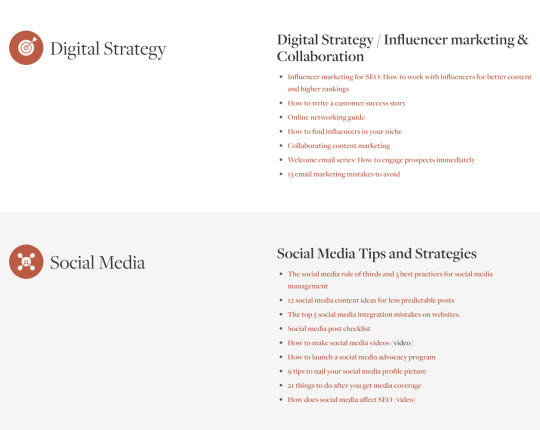
Your curated content should be no different. By assigning the right categories, topics, and tags to each piece you curate, your reader will be able to keep browsing through your curated content library and find exactly what they need.
Empower other teams
Curated content can be useful to everyone in your company. Think about it:
Sales team can reference it in their sales conversations (for example, when answering prospect’s questions or addressing a specific pain point)
Writers can use it to find relevant studies and examples to link to
Customer support team can use it to keep an eye on current industry trends around topics most important to your customers
Product development can reference it in brainstorming or problem-solving sessions
The options are endless, but the only way they can happen is if the structure of your curated content helps the right person get to the right topic quickly.
Hierarchy of your curated content
What is the right way to set up and organize your curated content so you can always find what you need quickly? Here’s a simple and effective structure you can start with.
High-level overview: Broad categories
First, define some broad categories that you typically cover in your content. There is no one-size-fits-all rule for this, but here are some starting points that can help. Your broad categories could reflect:
The categories you already use on your blog
Your product or service categories
The industries you serve
The teams in your company
Here are some examples for broad categories:
Law firm: data protection, employment law, healthcare, real estate
Marketing software: content marketing, social media, project management, email marketing
Web design agency: analytics, SEO, digital strategy, social media, web design, web development (this is exactly what earlier-mentioned Orbit uses as categories on their blog!)
Main focus: Core topics
Your topics are the center of your content curation strategy. They are the root of all the content that you curate.
Your curation workflow will be based on topics. In other words, when you find a fresh piece of content to curate, you’ll choose a topic to add it to.
Here are examples of topics based on some broad categories we listed earlier:
Employment law: legal tips for startups, workplace safety, contracts and procurement
Content marketing: content writing, content editing, creativity, content strategy
Analytics: Google Analytics, Google Tag manager, social media analytics
Detailed segmentation: Tags
Finally, you can further refine and label each piece of content you curate with tags. How you set up your tags is entirely up to you.
For example, you could use them as further branching of a topic into subtopics: creativity could have subtopics such as personal creativity, team creativity, psychology, leadership.
Another way to use tags is to label the format of each piece. This means your tags could be: article, video, webinar, podcast, PDF, research report, book. This also means that you could use the same set of tags across different topics and get used to the same segmentation in each of your topics.
Of course, you can experiment with different options and stick with the one that works best.
How to organize your curated content with Scoop.it
In sections that follow, we’ll show you how you can build your content curation structure from the ground up in Scoop.it.
Topics as the core of content curation
As we mentioned, topics are the foundation of efficient content curation efforts, and the same applies to how Scoop.it works.
To create a topic, you click the Create a Topic button from your dashboard. Then, you name it, make sure you’re happy with the topic URL, select a language, and confirm.

Topic customization
At the top of your new topic, you’ll see topic settings. This space will let you fully customize your topic.
Here are the options you’ll be able to tweak from the menu on the left-hand side:
Edit: title, language, description, user permissions for sharing and commenting
Sharing: connect your Twitter, LinkedIn, Facebook, Buffer, Pinterest, Yammer, or Tumblr account
Customization: change visual settings like images, layout, fonts, and colors for any element of your topic page
Automatic content import: set up RSS feeds and/or sitemaps
Teams: add authorized curators
Private: make your topic public to everyone, just your company, only you, selected users only, or make it password-protected
Lead generation: set up a lead generation form or integrate with Mailchimp
Topic group: add or remove your topic from topic groups
Topic groups
Once you’ve created all your topics, you can start grouping them into high-level groupings—broad categories.
In Scoop.it, these are called topic groups. To set them up, go to your company settings and choose Topic Groups from the left-hand side menu. Then, add the group and name it.
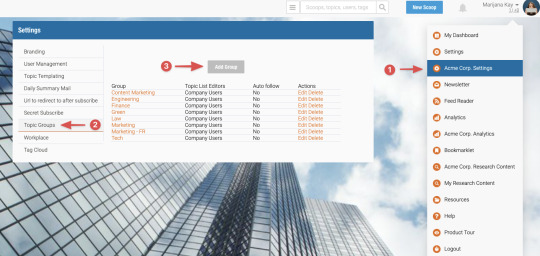
When you’re done, you can start adding topics to this broad category. For example, we could add our previously created content strategy topic to the content marketing category.
Use the search bar in the topic group settings to add your topics to it.

You can also set up the editors of this group to either company users or admin only.
Once you’ve created your topic groups and added relevant topics to them, you can easily access them from the three-line menu icon at the top bar of any page of your Scoop.it:

Tags
We started with topics, our content curation core. We then grouped them into larger categories. Finally, we can further segment our curated pieces and get specific thanks to tags.
Tags will let you easily navigate a topic and quickly get to the formats or subtopics you’re looking for. The best thing about them is that you can add them in a couple of seconds. It’s no extra work, but it still saves you time in the long run when you’re using these pieces later on.
When you curate a new piece of content to a topic, you’ll see this modal window that lets you add your insights and edit title and description. At the bottom, there’s a field to enter tags.
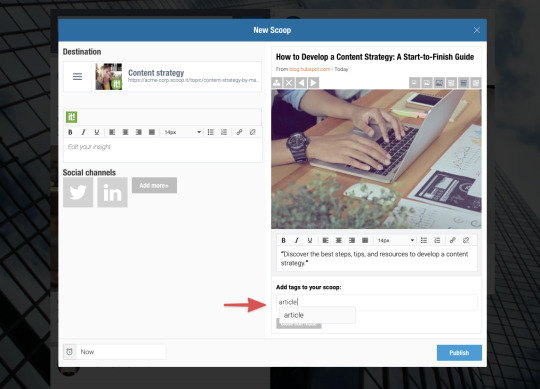
When you don’t have any tags, you can add them by typing in a tag name you want to create. After that, your tags will populate when you start typing so you can easily select them.
You can also add or remove tags after curating your content by clicking the tag icon at the bottom of each curated piece.
From here, your tags become the most powerful when you add them to the top of your topic page for easy access.
Click the funnel icon at the top right corner and click Add tag list as first Scoop.

This creates clickable tags you can use to filter content on a topic page. This is how these tags will look like on the page:

The more you curate and tag, the more impactful this section becomes. Remember the benefits of easy navigation through curated pieces, both for you and the rest of your company—a couple of seconds to add a tag are worth the effort!
If you want to see all the content with a specific tag (across all topics), instead of going to a topic page and filtering by tag, you can type in your tag in the search bar at the top. You’ll then see the option to click on a tag to view all company-wide content that has that tag:

Starred content
Finally, there’s a simple way to highlight a piece of content that’s currently most relevant: starring your content.
You’ll see the option to star a piece of content below it, alongside the sharing and tagging icons. When you click the star, that piece of content moves to the top spot on your topic page and stays there until you either unstar it or star a different piece.

This feature is great for bringing attention to a most relevant trend, report, or educational piece of content on a certain topic, and doing so quickly for everyone in your team and company.
Master your curated content organization and structure
With these tools and tips, you can easily access your entire curated content history and find the right piece of content within moments.
There’s no more need for frustration or time wasted on searching through hundreds (or thousands!) of pieces of content you’ve so carefully curated. Instead, you can focus on all the benefits that curated content can give you.
Want to see how this can work for you and your company? Get your Scoop.it Enterprise demo and take your content curation to the next level.

The post Why and how you should organize your curated content appeared first on Scoop.it Blog.
Why and how you should organize your curated content published first on https://wabusinessapi.tumblr.com/
0 notes
Text
Why and how you should organize your curated content

You already know the impact curated content can have on your business. From marketing efforts to employee advocacy and hiring, content curation is a company’s superpower across the board.
But curated content is only useful if you can navigate your way through it.
Think about it. Would a talented fashion stylist do their job well if they couldn’t find the piece of clothing they needed in a wardrobe? Would a skilled accountant be efficient if they spent most of their time looking for the right spreadsheet or document?
The answer, of course, is a resounding no. The chaos in the assets you use and rely on every day will make it harder to see the results you want and hit long-term goals.
Great content curation depends on a system and structure you understand and can use with ease. In this guide, you’ll learn how well-organized curated content benefits your business, the structure that works best, and some ways you can achieve it with Scoop.it.
Why organizing your curated content is essential
Let’s go through a quick overview of why this process is worth going through.
Find what you need, even after curating hundreds or thousands of pieces
Let’s say you curate five pieces of content every workday. In a week, that’s 25 pieces. In a month, you’ll have about 100 of them, which is 1,200 for the year.
After a full year, will you be able to find the exact piece of content you need and you know you have since 10 months ago? The answer is probably no.
On top of that, if you curate more than those five pieces a day, and especially if you get other people and teams in your company involved in curation, you’ll easily end up with a lot more than just 100 curated pieces per month.
The sooner you create a structure for your curated content in place, the less of a challenge you’ll have down the road. Reaching the right piece of content will take only a few seconds and clicks, and no curated content will ever get lost.
Create a great experience for your reader
Think about how you consume content. One great post on a blog leads to another great post on the same blog. A helpful YouTube video from a creator leads to their other useful videos.
Well-structured, labeled, and organized content, regardless of the platform, makes it easy to absorb and enjoy that content. It creates a seamless flow from one piece to the other.
One of my favorite “start here” blog pages is the one from Orbit Media. One of the main reasons they were able to build such an easy-to-navigate list of their best blog posts is their effort to categorize every post they’ve published.
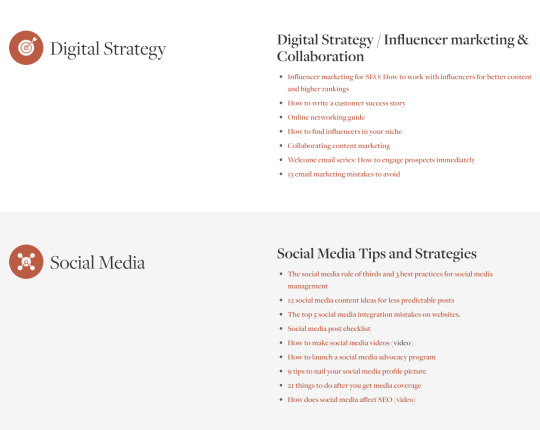
Your curated content should be no different. By assigning the right categories, topics, and tags to each piece you curate, your reader will be able to keep browsing through your curated content library and find exactly what they need.
Empower other teams
Curated content can be useful to everyone in your company. Think about it:
Sales team can reference it in their sales conversations (for example, when answering prospect’s questions or addressing a specific pain point)
Writers can use it to find relevant studies and examples to link to
Customer support team can use it to keep an eye on current industry trends around topics most important to your customers
Product development can reference it in brainstorming or problem-solving sessions
The options are endless, but the only way they can happen is if the structure of your curated content helps the right person get to the right topic quickly.
Hierarchy of your curated content
What is the right way to set up and organize your curated content so you can always find what you need quickly? Here’s a simple and effective structure you can start with.
High-level overview: Broad categories
First, define some broad categories that you typically cover in your content. There is no one-size-fits-all rule for this, but here are some starting points that can help. Your broad categories could reflect:
The categories you already use on your blog
Your product or service categories
The industries you serve
The teams in your company
Here are some examples for broad categories:
Law firm: data protection, employment law, healthcare, real estate
Marketing software: content marketing, social media, project management, email marketing
Web design agency: analytics, SEO, digital strategy, social media, web design, web development (this is exactly what earlier-mentioned Orbit uses as categories on their blog!)
Main focus: Core topics
Your topics are the center of your content curation strategy. They are the root of all the content that you curate.
Your curation workflow will be based on topics. In other words, when you find a fresh piece of content to curate, you’ll choose a topic to add it to.
Here are examples of topics based on some broad categories we listed earlier:
Employment law: legal tips for startups, workplace safety, contracts and procurement
Content marketing: content writing, content editing, creativity, content strategy
Analytics: Google Analytics, Google Tag manager, social media analytics
Detailed segmentation: Tags
Finally, you can further refine and label each piece of content you curate with tags. How you set up your tags is entirely up to you.
For example, you could use them as further branching of a topic into subtopics: creativity could have subtopics such as personal creativity, team creativity, psychology, leadership.
Another way to use tags is to label the format of each piece. This means your tags could be: article, video, webinar, podcast, PDF, research report, book. This also means that you could use the same set of tags across different topics and get used to the same segmentation in each of your topics.
Of course, you can experiment with different options and stick with the one that works best.
How to organize your curated content with Scoop.it
In sections that follow, we’ll show you how you can build your content curation structure from the ground up in Scoop.it.
Topics as the core of content curation
As we mentioned, topics are the foundation of efficient content curation efforts, and the same applies to how Scoop.it works.
To create a topic, you click the Create a Topic button from your dashboard. Then, you name it, make sure you’re happy with the topic URL, select a language, and confirm.

Topic customization
At the top of your new topic, you’ll see topic settings. This space will let you fully customize your topic.
Here are the options you’ll be able to tweak from the menu on the left-hand side:
Edit: title, language, description, user permissions for sharing and commenting
Sharing: connect your Twitter, LinkedIn, Facebook, Buffer, Pinterest, Yammer, or Tumblr account
Customization: change visual settings like images, layout, fonts, and colors for any element of your topic page
Automatic content import: set up RSS feeds and/or sitemaps
Teams: add authorized curators
Private: make your topic public to everyone, just your company, only you, selected users only, or make it password-protected
Lead generation: set up a lead generation form or integrate with Mailchimp
Topic group: add or remove your topic from topic groups
Topic groups
Once you’ve created all your topics, you can start grouping them into high-level groupings—broad categories.
In Scoop.it, these are called topic groups. To set them up, go to your company settings and choose Topic Groups from the left-hand side menu. Then, add the group and name it.
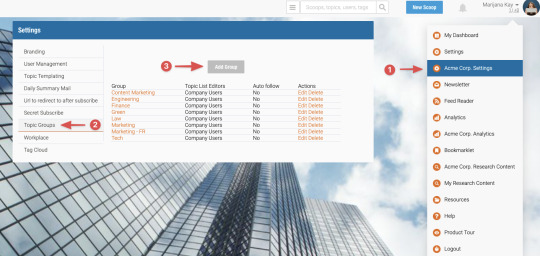
When you’re done, you can start adding topics to this broad category. For example, we could add our previously created content strategy topic to the content marketing category.
Use the search bar in the topic group settings to add your topics to it.
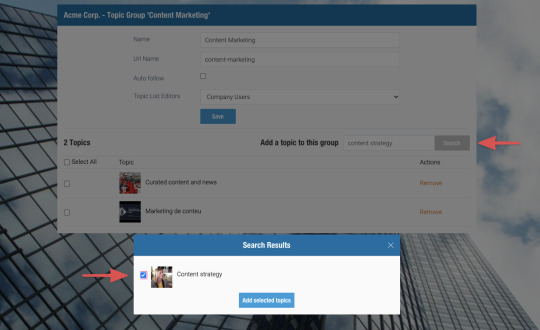
You can also set up the editors of this group to either company users or admin only.
Once you’ve created your topic groups and added relevant topics to them, you can easily access them from the three-line menu icon at the top bar of any page of your Scoop.it:
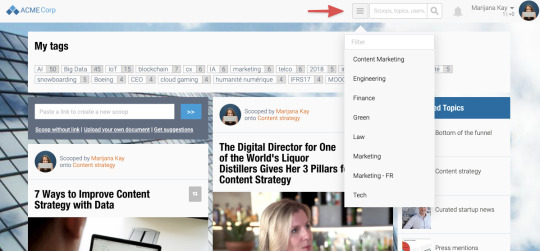
Tags
We started with topics, our content curation core. We then grouped them into larger categories. Finally, we can further segment our curated pieces and get specific thanks to tags.
Tags will let you easily navigate a topic and quickly get to the formats or subtopics you’re looking for. The best thing about them is that you can add them in a couple of seconds. It’s no extra work, but it still saves you time in the long run when you’re using these pieces later on.
When you curate a new piece of content to a topic, you’ll see this modal window that lets you add your insights and edit title and description. At the bottom, there’s a field to enter tags.
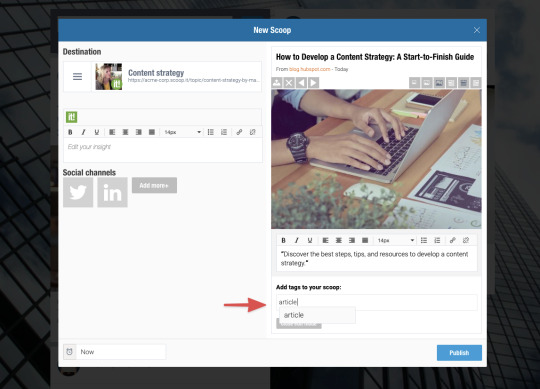
When you don’t have any tags, you can add them by typing in a tag name you want to create. After that, your tags will populate when you start typing so you can easily select them.
You can also add or remove tags after curating your content by clicking the tag icon at the bottom of each curated piece.
From here, your tags become the most powerful when you add them to the top of your topic page for easy access.
Click the funnel icon at the top right corner and click Add tag list as first Scoop.

This creates clickable tags you can use to filter content on a topic page. This is how these tags will look like on the page:

The more you curate and tag, the more impactful this section becomes. Remember the benefits of easy navigation through curated pieces, both for you and the rest of your company—a couple of seconds to add a tag are worth the effort!
If you want to see all the content with a specific tag (across all topics), instead of going to a topic page and filtering by tag, you can type in your tag in the search bar at the top. You’ll then see the option to click on a tag to view all company-wide content that has that tag:

Starred content
Finally, there’s a simple way to highlight a piece of content that’s currently most relevant: starring your content.
You’ll see the option to star a piece of content below it, alongside the sharing and tagging icons. When you click the star, that piece of content moves to the top spot on your topic page and stays there until you either unstar it or star a different piece.

This feature is great for bringing attention to a most relevant trend, report, or educational piece of content on a certain topic, and doing so quickly for everyone in your team and company.
Master your curated content organization and structure
With these tools and tips, you can easily access your entire curated content history and find the right piece of content within moments.
There’s no more need for frustration or time wasted on searching through hundreds (or thousands!) of pieces of content you���ve so carefully curated. Instead, you can focus on all the benefits that curated content can give you.
Want to see how this can work for you and your company? Get your Scoop.it Enterprise demo and take your content curation to the next level.

The post Why and how you should organize your curated content appeared first on Scoop.it Blog.
Why and how you should organize your curated content published first on https://improfitninja.weebly.com/
0 notes
Text
MaxMailz Review | Is it Better Then GetResponse??

So what's MaxMailz All About??
Meet The Unique 360 Degree Email Marketing Technology That Helps Power Your Business with none Technical Hassles!
All-In-One Solution
Everything you would like To Capture Unlimited Leads, Send Unlimited E-mails & Drive Unlimited Traffic To Any Website, Sales Page or Affiliate Offer
Get Everything Max
Max Leads, Max Email Delivery, Max Open & Click rate, Max Conversions & Max Sales With This Automated System
Automate Your Email Marketing
Set and Forget Advanced Follow-up Email Journey with Exclusive Marketing Automation Technology.
No Worries of Paying Monthly
During This Launch Special Deal, Get All Benefits At Limited Low One-Time-Fee.
50+ More Cool Features
We’ve Left No Stone Unturned to offer You an Unmatched Experience
Prices & Up-Sells
Front End :
Option 1 - MaxMailz Start Plan ($47)
Option 2 - MaxMailz Pro Commercial Plan ($49.95)
Features:
True 360 Degree Lead Capture
Unlimited Scheduling of Emails
100+ Beautifully Designed Various Lead Capture Templates
Behavior crop up Lead Capture Technology
Advanced Drag & Drop WYSIWYG Page Editor.
Exclusive Email Follow Up Journey Automated Technology
Seamless Autoresponder Integration
Use together with your Own Popular SMTP Service
Built In List Cleaning and List Checking
Advanced Spam Checker For Deliverability Boosting
Detailed and Precise Email Campaign Analytics
Smart Tagging Technology For Perfect List Segmentation And 50+ Features.
Upsell #1 :
Option 1 - MaxMailz Elite Monthly Plan ($37/Month)
Option 2 - MaxMailz Elite just one occasion Plan ($197)
Features:
Break Free & Go Limitless- Add Unlimited Contacts, Unlimited Email lists, Add Unlimited Custom Domains,
Add Unlimited Businesses, Get Unlimited website/page visitors, Drive Unlimited, leads from pages, Get Unlimited Bandwidth.
Create and Manage Unlimited Lists
Get Power to make Unlimited Businesses
Drive Unlimited Leads From Your Pages
Unlimited Advanced Follow-up Emails Journey With Exclusive Automation Technology
Advanced Subscriber Management With Suppression List
Duplicate Leadpages & Funnels In Between Businesses and Projects & Save Templates for Further Use
Create Lead Generations Journey with Exclusive Automation Technology
Get Maximum Registrants For Your Webinar With Webinar Integration
Team Management with Rights Control for Upto 10 Members
Add Unlimited Contacts
Add Unlimited Custom Domains
Unlimited Website/Page Visitors
Get Unlimited Bandwidth
Get 100 EXTRA Beautiful, Mobile-Friendly and Ready-To-Use Lead Pages, Popups And Email Templates
Get The Untapped Power To Send File Attachments With Emails
Advanced Campaign Management
Create Advanced Webinar Registration Journey With Exclusive Automation Technology
Maximize ROI From Your Leads With CRM integration
Downsell :
Option 1 - MaxMailz Lite ($67)
Features:
Add Upto 100000 Contacts For all of your Mailing Lists
Advanced Subscriber Management With Suppression List
Duplicate Lead Pages & Funnels In Between Businesses And Projects & Save Templates For Further Use
Create Lead Generations Journey With Exclusive Automation Technology
Get Maximum Registrants For Your Webinar With Webinar Integration
Team Management With Rights Control For Upto 10 Members
Get 100 EXTRA Beautiful, Mobile-Friendly and Ready-To-Use Lead Pages, Popups And Email Templates
Get The Untapped Power To Send File Attachments With Emails
Advanced Campaign Management
Create Advanced Webinar Registration Journey With Exclusive Automation Technology
Maximize ROI From Your Leads With CRM Integration
Upsell #2 :
Option 1 - MaxMailz Enterprise Personal ($47)
Option 2 - MaxMailz Enterprise Commercial ($97)
Features:
Advanced Analytics Of Your Email Campaigns to possess Clear Insight to spice up ROI:
You Can Even Create Unlimited A/B Testing For Lead Pages & Popups to settle on the simplest Performer
Effective Bounce Management
Get 20 MORE Mobile-Friendly and Ready-To-Use Lead Pages, Popups To Capture Maximum Leads For Your Business
Work Collaboratively & Share Proven Page & Journey Templates together with your Team Members, Clients & Group Of Marketers For Faster & Proven Page & Results
You Also Get Accurate Analysis for Team Member’s Activities For Effective Monitoring
Unlimited A/B Testing for Email Campaigns to settle on the simplest Performer
Get Pin Point Accurate Analytics Of Your Lead Pages & Popups to possess Clear Insight of what is Working & What's Not
Get 10 Premium & Professional E-Mail Templates
Share Control Of Your Dashboard To Up To 50 Team Members
Easily Remove Our LOGO From Your Email Footer, lead pages, Popups & Journey and present yourself as an AUTHORITY
Upsell #3 :
Option 1 - MaxMailz Business Drive ($47)
Features:
Store Your Media Securely & Share Faster together with your Clients
Share Files on Elegant, Brandable & SEO optimized Sharing Pages
Single Dashboard to Manage All sort of Files
Manage files in folders easily & share entire folder with clients or team members with Folder Management Feature
Get Maximum Visitor Engagement with Like/Dislike Option on Share Pages
Unbreakable File Security with Online Back-Up & 30 Days File Recovery Functionality
Manage & Share Multiple Files and save some time
Access Files Anytime, Anywhere with Business Cloud
Engage Maximum Audience with Royalty Free Stock Images & Videos- Pixabay & Pexels Integration
Advanced share page analytics to possess an entire insight on How Your Files do
Preview and Download the Files Before Sharing
Capture Unlimited Leads & Unlimited Audience from Share Pages
Get Full Text Search and Filters to Locate Files Instantly
Speed-Up Your Website Speed with Fast Loading & Optimized Images
Folders Effortlessly Enabled Login
Fetch & Sync Valuable Data Effortlessly with Google Drive, One Drive & Dropbox Integration
Upsell #4 :
Option 1 - MaxMailz Premium Membership Monthly ($27/Month)
Option 2 - MaxMailz Premium Membership One Year Deal ($197)
Option 3 - MaxMailz Premium Membership just one occasion Deal ($297)
Features:
Make Unlimited Profits – Add Unlimited Businesses-
Create UNLIMITED Beautiful, Mobile-Friendly & Fast-Loading Landing Pages
Build Unlimited Sales Funnels/Customer Journey from Scratch for Any Marketing Goal
Host & Play HD Videos with NO Delays & Buffering
Create UNLIMITED Personalized Notification Campaigns with 5 Powerful Engagement Apps in 1 Solution
Fully Customizable, Drag and Drop WYSIWYG Editor that needs Zero Designing or Tech Skills
300+ Battle-Tested, Done-For-You Templates to create High Converting Landing Pages, Funnels & Popups Fast & Easy.
Store & Share Business Files Securely together with your Clients & Team Members
Manage Leads, Monitor Lead Info & Timely Behavior Data to research Your Audience for Better Results
Smoothly A/B Test Your Landing Pages, Pop-Ups
Get Connected together with your Favorite Tools
Quickly Discover the Insights of Your Campaigns with Precise Analytics
Custom Domain to accentuate Your Brand Presence
Automatic & FREE SSL Encryption for Security
Here's Are Some Key Benefits you'll have an interest In Getting:
Helps You Get Huge ROI From Your Email Campaigns
100+ Stunning Designs For all of your Email Capture Needs
Full Drag and Drop Lead Page Builder
Create Engaging Beautiful Emails That Get Massive Clicks
Automate Your Follow Up Campaigns With Exclusive Email Journey Technology
FREE Commercial License Upgrade - Build a fantastic Income Offering Services To Clients!
https://mww411300221.wordpress.com/2020/06/22/maxmailz-review-is-it-better-then-getresponse/ https://www.instapaper.com/read/1317164680 https://www.instapaper.com/read/1317164678 https://www.instapaper.com/read/1317164675 https://www.instapaper.com/read/1317164674 https://www.instapaper.com/read/1317164672 https://www.instapaper.com/read/1317164676 https://www.instapaper.com/read/1317164666 https://www.instapaper.com/read/1317164667 https://my9ar3a.wordpress.com/2020/06/22/maxmailz-review-is-it-better-then-getresponse/
youtube
0 notes
Text
Top 10 Software courses will surely change your career in 2019
These 10 fields are currently growing very popular and will soon need skilled employees. Take up courses in these 10 fields and you are sure to climb the career ladder fast in future
he relationship between business and technology is constantly evolving. Organisations face new challenges while new technology is working overtime to support business goals. The right technology can launch businesses to a higher level of performance and achievement. Thus, certain upcoming fields are growing very fast and can prove to be great career fields if one chooses to take up courses in the same.
In technology, the prospects look exciting and some unexpected trends arise while old-timers merge with each other to enhance the overall impact. This year, we expect exponential changes in every area of technology.
Machine learning, and artificial intelligence will alter most industries, making way for virtual helpers and myriad cases for automatisation. We see huge potential for smart homes and smart cities, through the implementation of Internet of Things (IoT).
To keep pace with these trends and ensure that one’s career is advancing in the right direction, IT professionals need to strongly consider upskilling themselves in new technology areas.
They can look at effective e-learning platforms to master trending technologies of 2019 without going through the strain of getting to a physical classroom.
These 10 technology fields will rise high in 2019 and will prove to be great career paths:
1. Artificial Intelligence
Artificial Intelligence is one of the top fields of study that is rising fast in popularity and requirement.
Well, everyone knows a tad bit about Artificial Intelligence. As science fiction starts to become reality, AI products are slowly infiltrating our homes and workplaces.
Introduced by John Mccarthy in 1952, the idea behind AI is to mimic a human brain and to create a machine that has the power to think, analyse and make decisions of its own.
While we might think that AI is at least a few years away from causing any substantial effects on our lives, the fact remains that it is already having an enormous impact on us.
If you are using a smartphone now, you are interacting with AI whether you know or not. From the obvious AI features such as the built-in smart assistants to the portrait mode in the camera, AI is impacting our lives every day.
One of the biggest users of artificial intelligence is the online ad industry which uses AI not only to track user statistics but also serve us ads based on those statistics. Artificial intelligence is affecting our decisions and our lifestyles every day.
2. DevOps
It is a software development strategy which bridges the gap between the Dev and Ops side of an organization, for seamless delivery of software. It was introduced because there were limitations in the traditional model.
There is a need to release small features more frequently and without DevOps it is not possible.
Best DEVOPS with AWS Training in Hyderabad With Certification, Live Classes – 1-on-1 Industry Mentorship – Hands-on Exercises
To understand various DevOps tools, one needs to study the scripting language, infrastructure code etc.
3. Cybersecurity
With the rising cases of cyber threats, cybersecurity is a much-needed career field now.
Keeping in mind recent data breaches that have been committed in the tech industry, the Global Data Protection Regulations were revamped.
This has, in turn, resulted in an increase in demand for cybersecurity personnel who can cope with the changes and keep a company free of any sort of compliance issue.
Regardless of recent events, cybersecurity is an evergreen field and working personnel are always kept on their toes so that they can constantly keep updating themselves about the latest creative attacks that are being formulated every day, so that any sort of compromise in security can be mitigated.
Also Find Few trending courses on demand for you and your friends
Advanced Google Analytics Training
Best Google Tag Manager (GTM) Training course
SAP HCM SuccessFactors Training in Hyderabad
asp .net with c# course training in Hyderabad
4. Augmented Analytics
While some may call it augmented analytics, others may call it Smart Data Discover, but at its core, it involves the integration of BI and AI to automate the processes of finding data, preparing for analysis and generating insight.
It identifies trends and explains what these practically mean for business through clear visualizations and neatly packaged trends.
The purpose here isn’t to replace the decision-making system, but to support it. One feature of augmented analytics that sets it apart from other technologies is its ability to carry out natural language generation which unpacks complex jargon and provides simple insights.
Users can also go beyond opinion to get insights and act on data quickly and accurately.
5. 5G Network
With much anticipation to roll out across the world in the coming years, 5G network is the latest iteration of cellular technology.
This will be the next generation of mobile internet connectivity which is a combination of cutting-edge network technology and research.
They offer faster speeds and more reliable connections on smartphones and other devices.
These networks will give a good start to the Internet of Things and will have an average download speed of 20GBps per second.
6. Autonomous Things
Today, intelligent behaviour can be replicated and even the non-living can be empowered with self-capable features.
Autonomous Things take the advancement of Machine Learning a step further based on AI and IOT, to enable complex decision making autonomously in devices and objects.
It can enhance any object in our surrounding to think and respond by themselves.
This technology will be commercially relevant technology in 2019 and envisions to make self-driven vehicles, drones and robots a common reality by 2020.
7. Digital Twins
While the concept of a Digital Twin has been there since 2002, it is only thanks to the Internet of Things that it has become cost-effective to implement.
A digital twin is an integrated multiphysics, multiscale, probabilistic simulation of an as-built vehicle or system that uses the best available physical models, sensor updates, fleet history etc. to mirror the life of its corresponding flying twin.
For example, how do you operate, maintain, or repair systems when you aren’t in physical proximity with them? That was a challenge NASA’s research department had to face when developing systems that would travel beyond the ability to see or monitor physically.
This pairing of the physical and virtual worlds allows analysis of data and monitoring of systems to head off problems even before they occur and plan using simulations.
8. Edge Computing
Today billions of devices are producing data at an explosive pace, stressing the limits of modern data centres and networks.
To tackle this challenge, organizations are taking pressure off their centralized data centre’s through edge computing solutions.
Edge computing is basically pushing the frontier of computing applications, data and services away from centralized nodes to the edge of a network.
By moving data centres to the edge of the network closer to consumers, it speeds storage, processing, and analytics of data nearby, before sending it back to the centralized data centre.
This ultimately drives better performance, faster response time and greater innovation
9. Quantum Computing
These are machines in new avatars that promise an exponential growth spurt in processing power, capable of tackling problems which our computer can’t solve today.
Over 50 years of advancement in mathematics, material science, and computer science have transformed quantum computing from theory to reality.
Tech giants like IBM and Google and start-ups like Righetti Computing are in a scientific race to build the first universal quantum computer.
Quantum computers can analyse large quantities of data and spot patterns quickly, they could tackle optimization problems for transportation and industry, advance climate modelling and boost artificial intelligence research one day.
Quantum computers are still in the experimental stage, but their raw potential is sure to cause a paradigm shift in computing physics and potentially our understanding of the world today
10. Immersive Experience
Immersive experience basically integrates augmented reality and virtual reality. For example, what if we can create digital environments for human to experience the impossible?
Through a mix of data science, artificial intelligence, and creativity, virtual and augmented reality offers opportunity to train and plan in a safe environment, without consequences.
From battlefield simulations to hospital management scenarios, this technology better prepares a team for mission success.
To make a truly transportive experience, audiences crave the sensory richness we would find in the real world around us-not only visually-but in the care and attention to sound, scale and the imagined world off-stage.
Equip yourself with Edureka’s live, online technology courses that offer you the flexibility to learn at your own pace, so that you can work as well as upskill at the same time. Make 2019 your year take a career leap or qualify for the dream job you always wanted
-Article Credit goes to indiatoday.in
Related Article for you
Related Articles:
Core Java, Strings Developer - Online Technical Support from India
Get C#, Java Selenium | SpecFlow Automation Testing Support India
IBM Sterling B2B Integrator Online Training – 100% Practical
IBM Sterling File Gateway (SFG) online Training – 100% Practical
Get Manual Testing Online Technical Support by Skilled Consultant
Online Job Support from India | Asp.Net, MVC, Selenium Testing C#
Get ASP Net, MVC Developer JOB support |Online Technical Support
Software Testing Tools Courses Training from industry Experts
0 notes
Photo

New Post has been published on https://www.simicart.com/blog/progressive-web-apps-features/
9 Must-Have Features of a Progressive Web App (PWA) for E-Commerce
E-commerce is one of the top-growing sectors for Progressive Web Apps (PWAs). PWAs allow businesses to deliver great app-like experience on the web to effectively engage and convert customers. Due to its high performance, online businesses of all sizes are finding PWAs the best fit to replace their slow, clunky websites. The number of PWA adoption is increasing among ecommerce websites, but not all of them are actually generating added value for their online stores.
Having a PWA for your business is the right move to make, but it does not necessarily guarantee success.
Meanwhile, businesses with the most successful PWA storefronts have one thing in common: They are committed to improving customer experience by enriching their online stores with innovative features.
If you’re thinking of building your PWA-based store or already have a live PWA, make sure these must-have features are included to offer a solid shopping experience that ultimately impacts your bottom line.
The list has been narrowed down to 9 must-have features of a Progressive Web App (PWA) for E-commerce
Must-Have Features for Your E-Commerce Progressive Web App (PWA)
1. Mobile-first interface
Built primarily for mobile, PWAs require a mobile-first approach when it comes to user interface design. By aligning its components with mobile device’s unique features, you can tailor the PWA interface to mobile users. It’s important to forget about conventional web design when designing for a PWA. In terms of experience, A PWA is much like a typical native app from the user point of view. So it’s great to take native app design as inspiration and benchmark to build an app-like interface. Your PWA should be built around user expectation of a native app to reach its full potential and deliver a mobile-first experience in your online store.
In case you need something inspiring to create your own PWA, check out our list of best PWA examples.
2. Social integration
Integrations with your customers’ favorite social networks are great for acquisition and engagement of your PWA. Using social media platforms you can streamline registration process for new users by letting them log in quickly via preferred social account. It removes the hassle to fill a long form before enjoying the benefits of signed up customers.
Social integration provide even more meaningful ways for your online users to interact with your brand: it allows customers to share their wishlist, orders and reviews via social networks. They can like your products and categories and post comments on your store products pages. All these capabilities ultimately lead to higher brand visibility on social networks, which is much effective to attract high quality new users for your online store.
3. Web push notification
For businesses looking to engage more users in their PWA store, web push notification will be one of their most-used features. Push notifications provide the most personal channel to connect with customers in real-time, on their smartphones. With a simple one click opt-in directly from the PWA, targeted push message can be sent to user’ device based on location or behavior. These notifications look and feel just like those from native app, even if the browser is not currently running. Web push messages have delivered drastically higher engagement and retention from push-enabled users, according to case studies by Google.
Successful businesses are leveraging this channel as a crucial part of their mobile engagement strategy, as it’s shown valuable impact on their bottom line.
4. Reporting & analytics
Another feature that all the best PWAs have in common is Analytics. The best way to optimize your PWA performance is having a comprehensive Analytics system integrated into the web app. With integrated analytics, you can have a bird-eye view on user patterns and overall performance of your PWA. To achieve that, the analytics system collects and report data so you can make sense of user experience within the web app and identify area for improvements.
While offering unique functionalities like offline mode, PWA can be more complicated to track its events if users are offline. To deal with this, popular analytics system like Google Analytics, Mixpanel,.. have embraced the capability to collect data regardless of internet condition. Offline events can be queued and sent to the system when network is available. Keeping track of these data on a regular basis allows you to optimize your PWA for deeper engagement and better conversion, which ultimately translate into sales growth.
5. Live chat
As the most preferred support channel, offering live chat on the PWA store is a must for any customer-centric business. For your online business, live chat is the best way to stay connected with customers and help them through their pain points. For customers, using live chat is the most convenient way to access an online support agent and get instant response to their inquiries right when they’re browsing your PWA.
By proactively reach out and resolving problems quickly, online businesses can better manage engagement experience and build more valuable customer relationships. The must-have feature is proven to increase purchases, boost customer loyalty and spread positive brand experience through word-of-mouth.
6. Enhanced checkout
Allowing users to complete desired task quickly is the major advantage of a PWA. Because ecommerce PWAs are all about making online purchases, checkout is the main area for optimization if you want to create great revenue for your business. To achieve that, a set of features and functionalities to help customers complete checkout quickly and easily is required.
According to your business particular needs, you may turn to address auto-complete, one-page checkout or one-click purchase features to streamline experience for online shoppers. Using these checkout enhancements, businesses can create a fast and seamless path to complete order that maximize conversion and revenue. The simplified checkout process is well-suited for a PWA where converting sales is the most prominent goal.
7. Web payments
Payment request is a perfect feature to optimize PWAs for quick task completion. The new API by Google – Payment request promises to improve payment experience for web users from the ground up. It eliminates checkout form for online shoppers by combining shipping, billing information and payment method into one step. The standard enables fast and seamless payment processing that allows customers to pay easily via its native UI. Supporting various payment systems, payment request makes it easy to integrate any type of payment method to fit user preference and business demand.
Learn how payment request works on shopping sites in the below video:
youtube
8. Security
Security should be a top priority for every online business. Having control over your site’s security is required for it to be recognized as a PWA. To be more specific, you need to serve your web app via HTTPS with a security certificate. It makes sure that all online users have a secured connection to your PWA by safeguarding any data transfer between them and the server. Using HTTPS for the entire site helps protect payment transactions, secure user accounts, keep their communications, identity and browsing private.
With HTTPS enabled, it will automatically be marked as secured by the browser, which is visible to any visitor to your PWA. Showing visitors that the PWA is secured can build trust among your customers, improving sales and conversion accordingly. Plus, sites using HTTPS will receive a healthy boost in their search rankings by Google.
9. SEO optimization
In favor of discoverability, PWAs can be indexed by search engines, making great app-like experience accessible from the search results. However, a PWA is not friendly to search engines by default. There’re several technical challenges involved in making sure that the PWA is discoverable. Typically, search engines treat PWA like a JavaScript-based site, which results in some issues that may impact its SEO performance. When SEO is optimized properly, PWA can provide business with great benefits in terms of visibility and customer acquisition. To ensure your PWA is appropriately indexed, check out some common SEO optimization tips for PWAs – as recommended by Google:
Provide canonical tag when serving content from various online sources to avoid duplication.
Make use of Fetch as Google tool to test how Google index your PWA.
Make sure the page don’t use fragmented identifiers (everything after the hash symbol in its URL) as Google will ignore them.
Use Schema.org metadata that matches your page content to improve its appearance in search engines
0 notes
Text
7 Must-Have Online Marketing Tools for Startups
By Garvit Bafna
Starting a business is not easy… but making it successful in the long run is an even greater challenge.
A big chunk of startups will fail and only a few select ones will be able to survive. Among the startups that succeed to exist, only the creme de la creme will go on to become world-renowned brands.
In the totally dreamy, almost filmy startup world, dreams do come true. However, it’s not only with sheer luck that startups like UberCab transform into ubiquitous brands like Uber and become the most valued privately held company in the world. A lot of hard work, resilience, grit, and belief go into making a startup successful.
What do all startups need?
One common qualifier for startup success is easy availability of tools and resources. This is where the Internet plays a major enabler for all startups, as it practically provides an unlimited number of resources and tools for every need a startup founder can think of. And since most startups are bootstrapped, their founders like things that are easy on the pocket and big on functionality.
That is why online advertising has such an insatiable appeal for startup founders. It provides a cost-effective way for newly established brands to market their products or services to a target audience with a lot of precision, compared to other forms of advertising.
For a startup, an awesome online marketing strategy needs a seamless implementation for getting more bang for their buck. A badass implementation needs badass tools to implement, monitor, analyze, calibrate and evaluate a campaign.
In this post, we will discover seven must have online marketing tools that every startup needs. Without further ado, let us figure out how these awesome tools can help a startup founder run a tight ship and sail merrily into the sunset.
1. Google tools
The genius of Google lies in its ability to keep a lot of its products free to use. From a marketing perspective, three Google tools are a must have: Google Analytics (aka GA), Google Tag Manager (aka GTM) and Google AdWords Keyword Planner.
Google Analytics and Google Tag Manager are two important tools to track visitor data on your website. Together, both of them work in tandem to give better visitor data to analyze. All startup teams need data, a lot of data to enhance their products and services.
Why is data important?
A successful online marketing campaign entails processing a lot of data, both during and after the campaign. Data can allow marketing teams to take measurable actions in order to improve the campaign.
Imagine if a marketing team knows that most of their conversions are happening on iOS devices, then they can easily change targeting of their campaign and push more ads to people using iOS.
This simple insight from data can save a lot of marketing dollars and help get more conversions. In today’s data hungry time, this saying by William E. Deming hits a bull’s eye:
How to crack keyword analysis
Google AdWords Keyword Planner is a keyword and traffic research tool by Google that allows advertisers to easily create PPC campaigns. More importantly, it is a very essential tool to do keyword research for your SEO efforts. For any sound SEO strategy, it is important to know which keywords to target. Keyword planner provides a wide range of functions.
One can see what their target audience is searching for, which keyword queries can lead a user to your website, understand search volumes of a keyword, and see user search queries based on Geographic locations. It’s primary focus, however, is to allow marketers to easily create ad sets and run a PPC campaign. And, of course, pay Google some monies.
2. HubSpot
HubSpot Marketing is essentially a lead capture and management tool. It has great features to create campaign landing pages, track leads, manage communication with leads in one place, and increase traffic and conversions.
Inbound Marketing with HubSpot
HubSpot is primarily used for inbound marketing and if set up properly, can be helpful in automating the marketing workflow.
It essentially helps in the following:
Attracting more traffic to your website by using its features for creating landing pages, email campaigns, & blogging.
Managing website traffic by providing a lead management tool and automating marketing workflows using targeted email drip campaigns.
Using a data analytics tool to see key insights about each marketing campaign and understand lead progression through the funnel.
A/B testing landing pages, capitalizing on an inbuilt CRM tool, or integration with Salesforce for tracking customer communication at each interaction point.
From getting somebody interested in your brand’s proposition to ensuring that customers get world-class service, HubSpot Marketing is a really powerful tool for brands to make their marketing blues go away.
HubSpot Dashboard
It is available for free with limited features enabled and one can opt for paid plans as per their need and budget. Basic plan starts at $200 per/month when billed annually.
3. Marketo
Another marketing automation service that works in a similar fashion as Hubspot is Marketo. It allows brands to build marketing strategies from the ground up and integrate across channels, be that on the website, social media platforms or email campaigns.
Marketo vs Hubspot
Marketo is in direct competition with HubSpot, so much so that HubSpot have a dedicated FAQ page on their website comparing user reviews for both products. In terms of function, both Marketo and HubSpot offer similar features.
However, they do have quite a few differences as well, giving brands ample room to choose between the two, depending on their requirements. The key differentiator is the price. HubSpot is cheaper compared to Marketo and leaves marketing teams with more budget to spend on other stuff. In terms of product/service experience, both fare equally and provide the same level of customer satisfaction.
B2B Marketing with Marketo
Marketo is known to be Pro-B2B businesses as they put more emphasis on nurturing a lead in their workflows whereas HubSpot is oriented for inbound marketing for B2C businesses. Marketo is preferred by teams who need a customized solution and have in-house IT teams to help them run the Marketo setup over their workflows.
Though HubSpot wins in its ease of use and handy inbuilt CRM that many teams want, Marketo integrates seamlessly with Salesforce, SAP, SugarCRM, and Oracle. Depending on your budget and the kind of customers you are serving, Marketo can be a better solution, especially if you are starting up in the B2B space.
4. Mailchimp
Have you ever wondered how many emails are sent worldwide in a day? An estimated 205 billion emails a day were sent in 2015. That equals 2.4 million emails in a second and 74 trillion emails in a year. The math is mind-boggling and points to a growing use of email as a communication tool for brands. Out of this humongous mass of emails, almost 50% is spam.
Why Mailchimp?
Out of the 205 billion emails sent daily, Mailchimp boasts of sending at least a billion of those. That would equate to around 0.5% of all emails sent worldwide in a day that Mailchimp sends on behalf of its customers. An interesting figure to understand the rising popularity of email marketing services and why marketers need to sign up for one.
Another factor that matters in email marketing is the spam email conundrum. Since half of all emails are spam, email providers like Google, Yahoo, Microsoft etc. have inbuilt features that filter out the spam emails and label marketing emails as spam if they are coming from an untrustworthy domain/IP.
With respect to email marketing, getting your domain’s, IPs whitelisted is critical in order to increase the chances of emails reaching a user’s Inbox. And using a service like Mailchimp allows marketers to have a more reliable service working on their behalf to deliver emails to a user’s inbox.
Setting up Mailchimp
Mailchimp is an easy to use service for sending emails to your customers and prospects. Think of it as a module for sending out nicely designed newsletters to all of your mail contacts. They have a lot of theme based options available.
What’s the use of sending Emails?
For a brand, it is important to constantly engage with prospects and customers and email marketing plays an important role in achieving that. According to a Direct Marketing Association report, 66% of online consumers have bought something because of an email marketing communication.
Integrating MailChimp
Mailchimp allows Ecommerce store owners to integrate its services with their websites. This integration allows for automating product follow up emails, in stock messaging and other mail communications that can be set up effortlessly.
It has third party integrations with major tech platforms like Magento, Shopify, WordPress, Salesforce etc. As with most SaaS available online these days, a basic version of Mailchimp is free to use without any charge. Paid plans start from $20/mo.
5. Optimizely
The best part about online advertising is its ability to quickly provide feedback in real time and allow marketers to act on it while the campaign is still running. In an online advert, you get real-time data about impressions, clicks and conversions to know if your campaign is working or not.
It is this simple premise on which online advertising scores over traditional mediums. Though print has its advantages and still has an appeal for marketers, online advertising is the preferred choice for startups to spend their marketing dollars.
It allows marketers to optimize their campaigns in ways unimaginable a decade ago. And this is where we meet our next hero: Optimizely. Their tagline says it all:
“World’s leading experimentation platform”
What is Optimizely?
Dramatic copy aside, Optimizely is one of the best tools for optimizing your campaigns. They are pioneers in providing tools to successfully conduct A/B testing, a technique that is a hot thing in the startup world. A/B testing is a simple way of testing two versions of a webpage or an app to see which one fares better.
This empowers brands to make decisions based on data they collect from the A/B testing experiment. Essentially businesses can make more informed decisions instead of just guessing if their webpage or app design is working or not. Platforms like Optimizely enhance the user experience of an application using data from actual users.
Is Optimizely for me?
On low traffic websites and apps, insights from Optimizely might not be as useful, since the sample data set would not be big enough for Optimizely to suggest accurate insights. So if you have enough traffic and budget, opting for a platform like Optimizely will be a good decision.
It is one of the best “experience optimization platforms” that is out there. Optimizely is a well-funded San Francisco startup with a total funding of around $150 million till date. It has delivered more than 700 billion custom experiences to its customers. You can opt for a 30-day free trial and learn how the platform works and see if it is something you would like to pay for.
6. Buffer
Social media plays an important role in a startup’s success. As we become more social online and sign up for all sorts of social networks, businesses will need to keep up and find ways to engage with consumers on social media.
On an average, each Internet user has signed up for 5 social media accounts. For a brand that equates to having presence on more social media channels and spending more resources in maintaining that presence, it is important to streamline their social media strategy.
Streamlining social media
Buffer is one such tool that will help to streamline your brand’s social media strategy. It is essentially a publishing platform used for scheduling and publishing content on social media. If it weren’t for tools like Buffer, posting numerous times on 5-6 different platforms in a day would be a nightmare. As we optimize social media post frequencies, tools like Buffer help in maintaining a relevant social media presence.
Buffer provides an option for posting on major social media platforms like Twitter, Facebook, Instagram, Linkedin, Pinterest and Google Plus. You can publish and schedule posts on all supported platforms, aggregate content from RSS feeds and post/schedule that content, connect with social automation tools like IFTTT, use inbuilt URL shorteners, social analytics, collaborate with different teams, and even create social media image posts using the newly launched feature called Pablo.
Buffer has a mobile app to allow people to work on it while on the go. It offers a freemium plan for individual users with limited features and posting capabilities. Paid plans start at $10 and run up to $390 for larger teams and bigger requirements.
7. Canva
The most important factor for posting on social media is creativity. User engagement increases only if your posts are designed beautifully and have something interesting to say. And for creating beautiful designs we need products like Canva. It’s a cloud-based service that enables non-design people to start designing. Their tagline sums it up quite nicely:
“Empowering the world to design”
Design unplugged with Canva
In a startup, being scrappy is paramount to success. And tools like Canva can be used to do a lot of things. The best part about Canva is its ease of use and capability to allow practically anyone to create engaging content.
Capabilities of Canva
Using Canva one can design social media posts, presentations, blog graphics, posters, letterheads, brochures, logos, flyers and much more! There is hardly a marketing collateral that you cannot design using Canva.
Canva dashboard
This above screenshot shows only a handful of collateral that can be made using Canva. You’ll have to register to see all of what it has to offer. Much like the rest of tools discussed in this post, it is free to use and has a lot of features available for free users. Paid plans provide features like unlimited folders, priority support, and collaboration for up to 50 team members.
Guest Author: Garvit is a digital native and totally digs the internet. Currently, he is heading operations at Art Attackk, an award- winning creative digital agency in New Delhi, India. Besides managing the chaos that ensues in a creative agency he likes to write, dabble in amateur filmmaking and traveling.
The post 7 Must-Have Online Marketing Tools for Startups appeared first on Jeffbullas’s Blog.
from 7 Must-Have Online Marketing Tools for Startups
2 notes
·
View notes